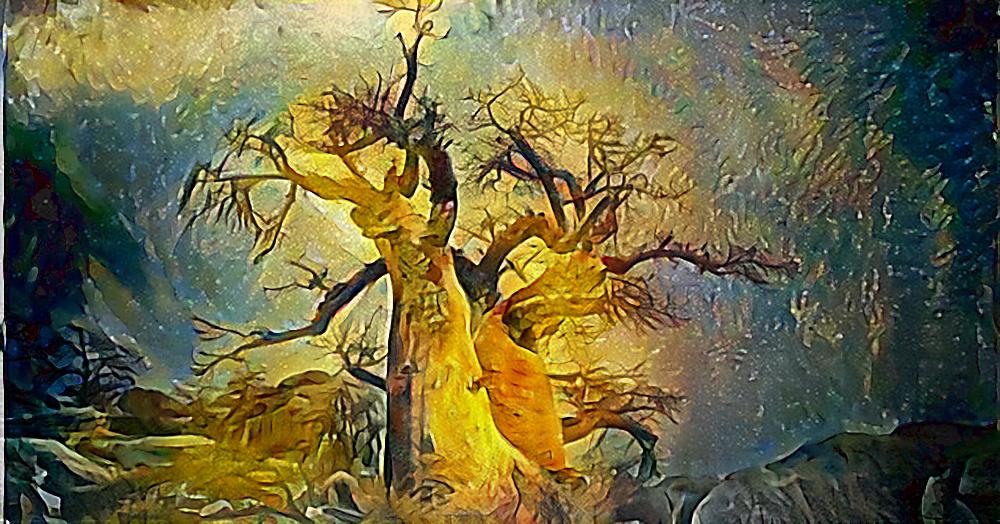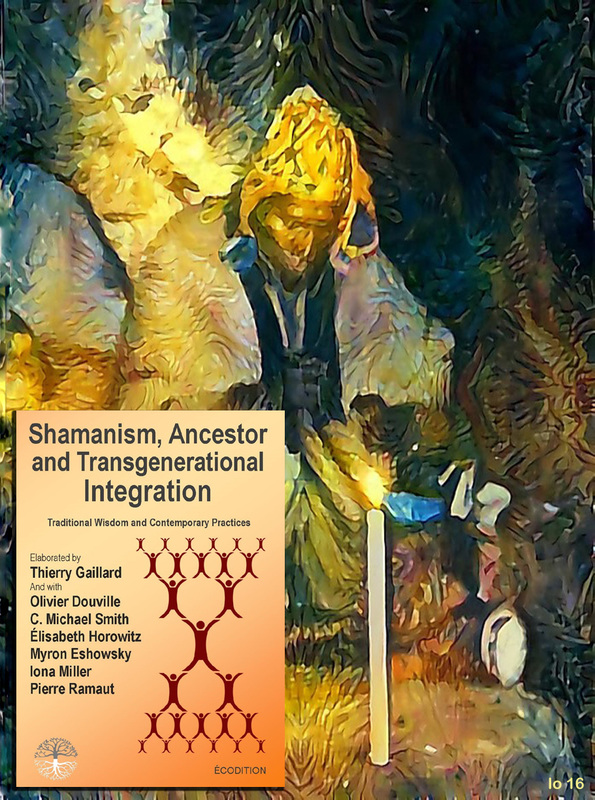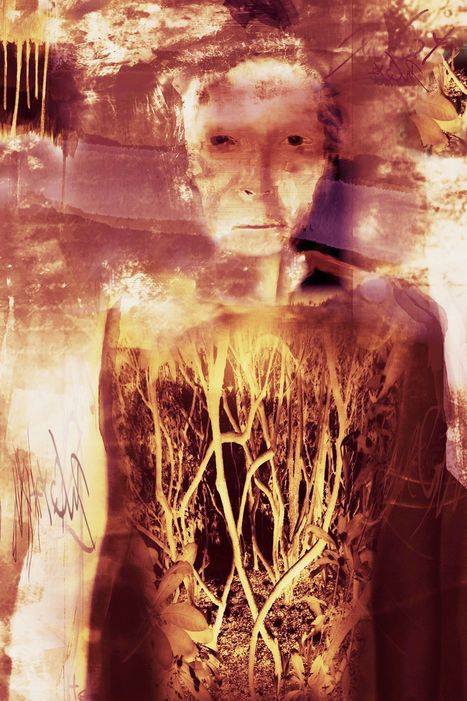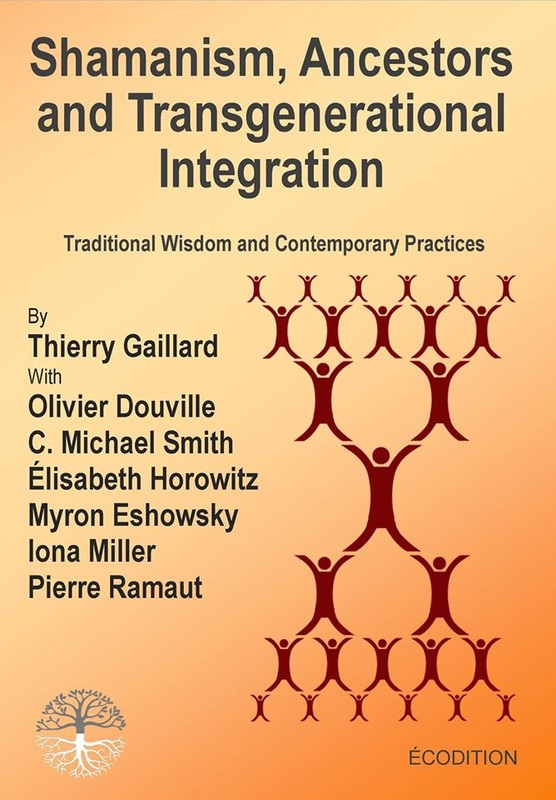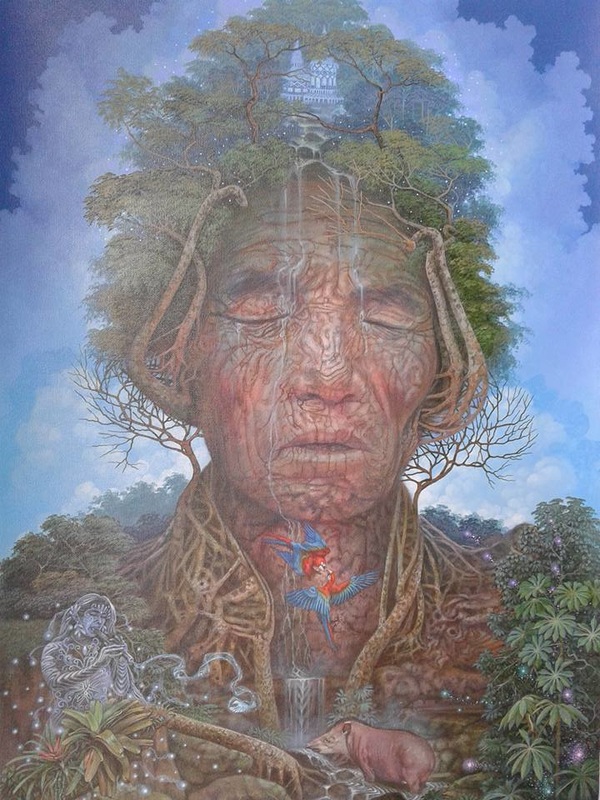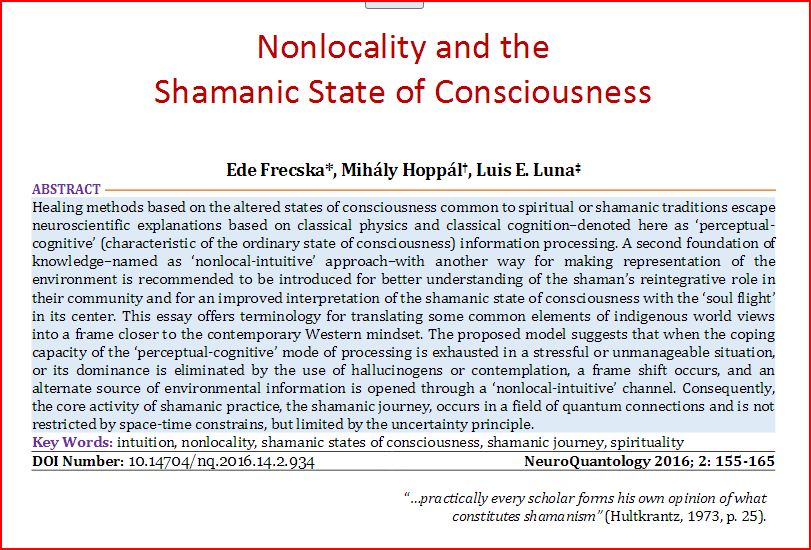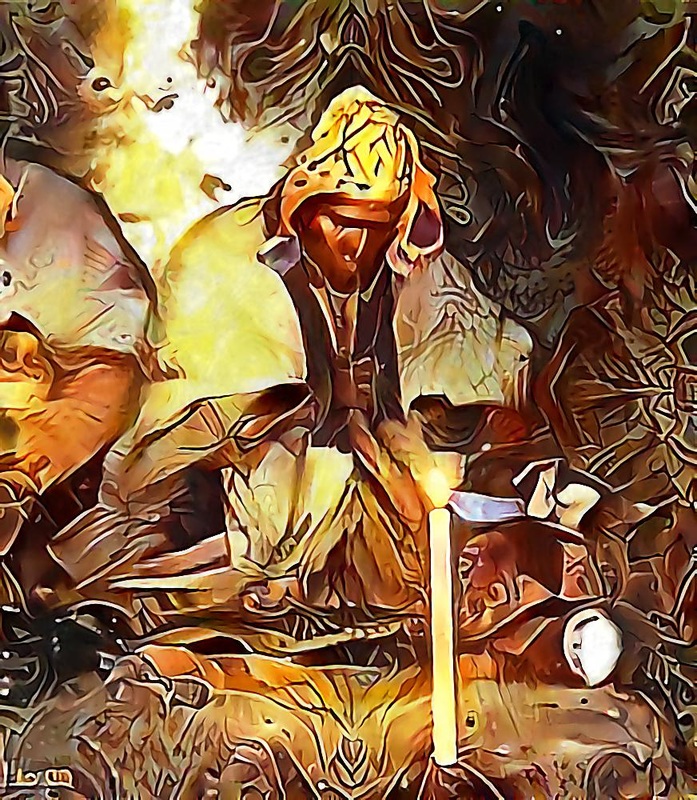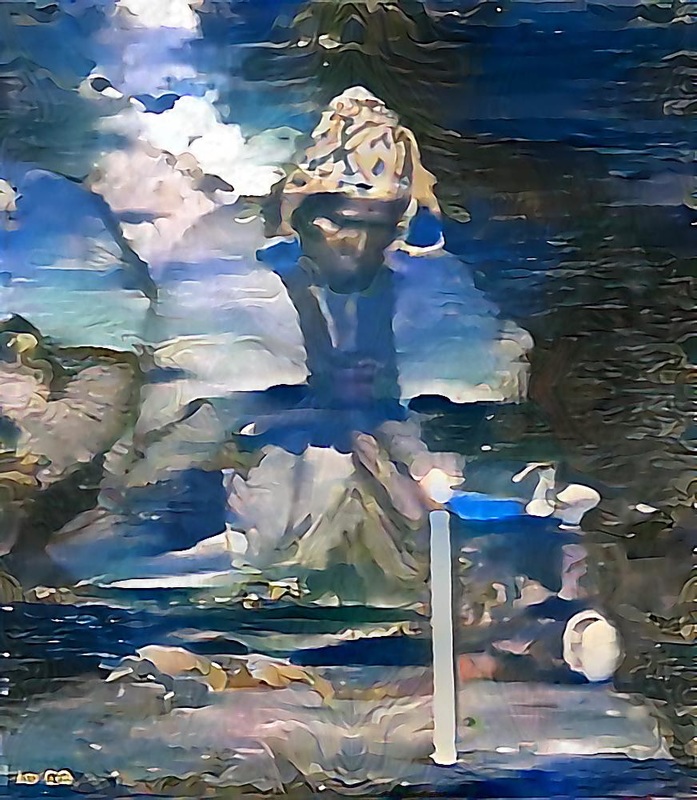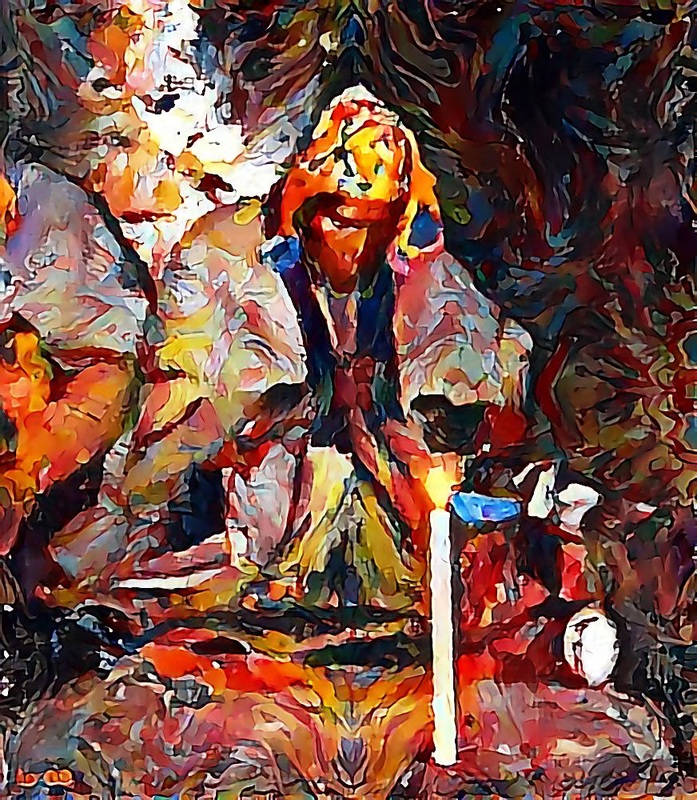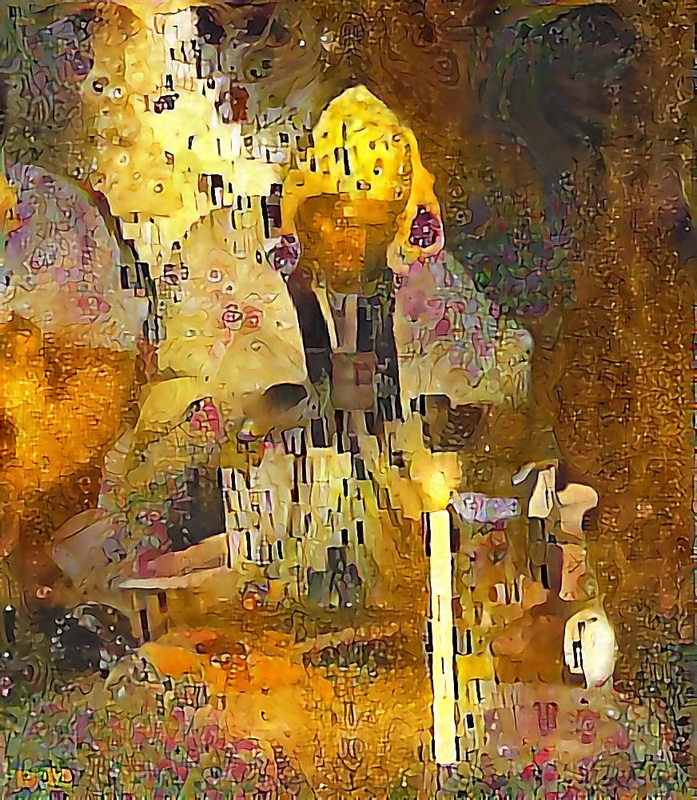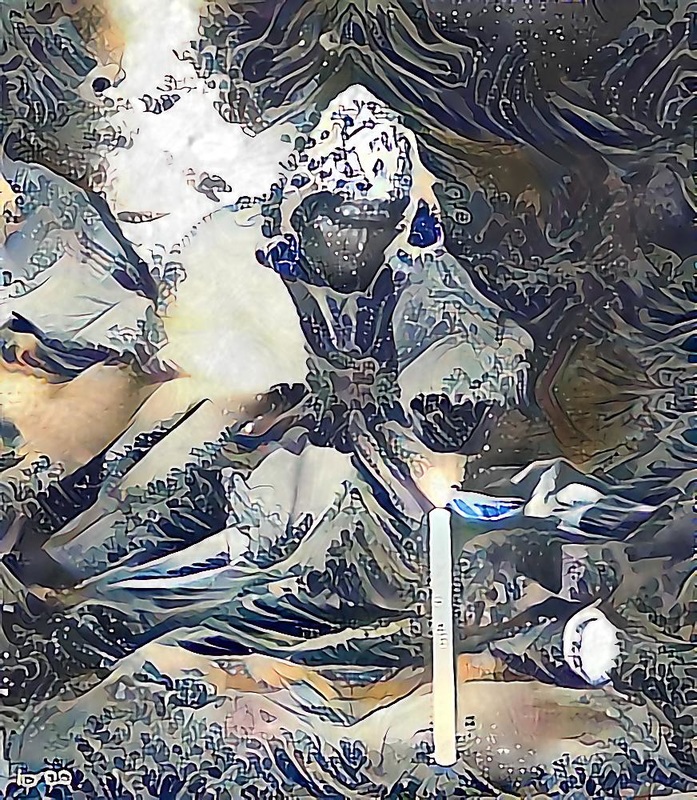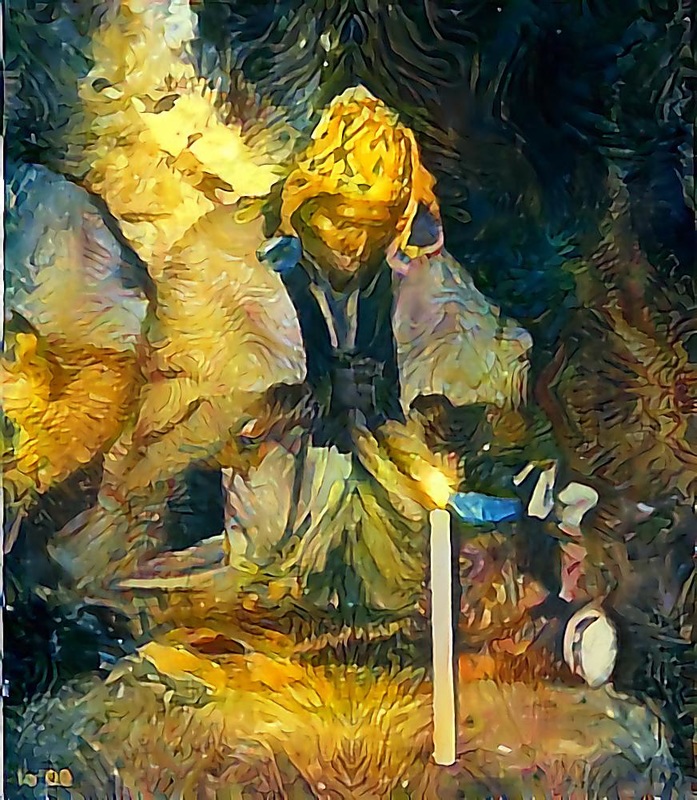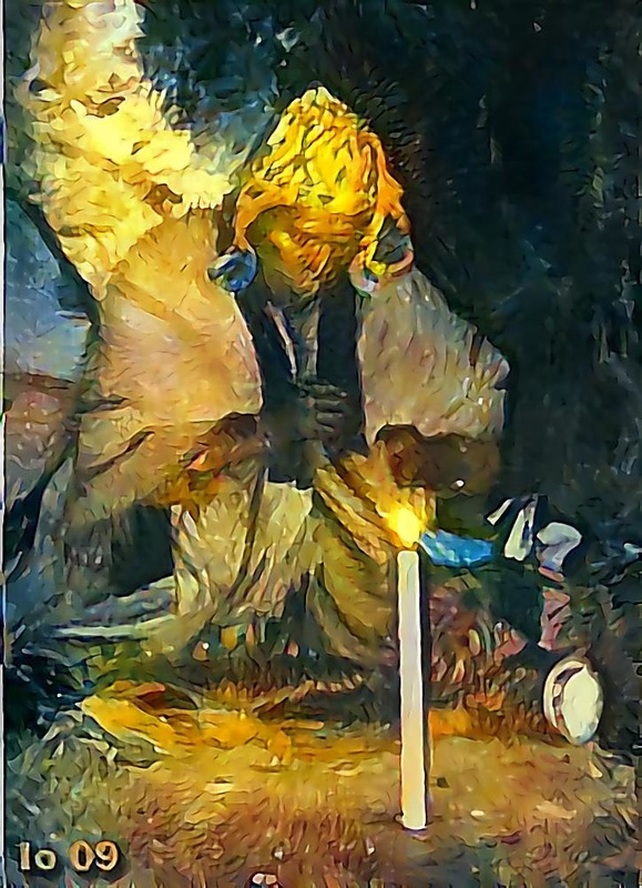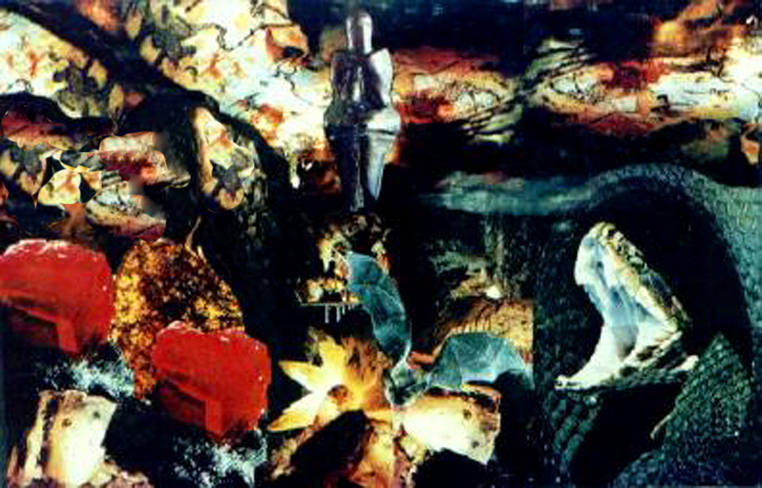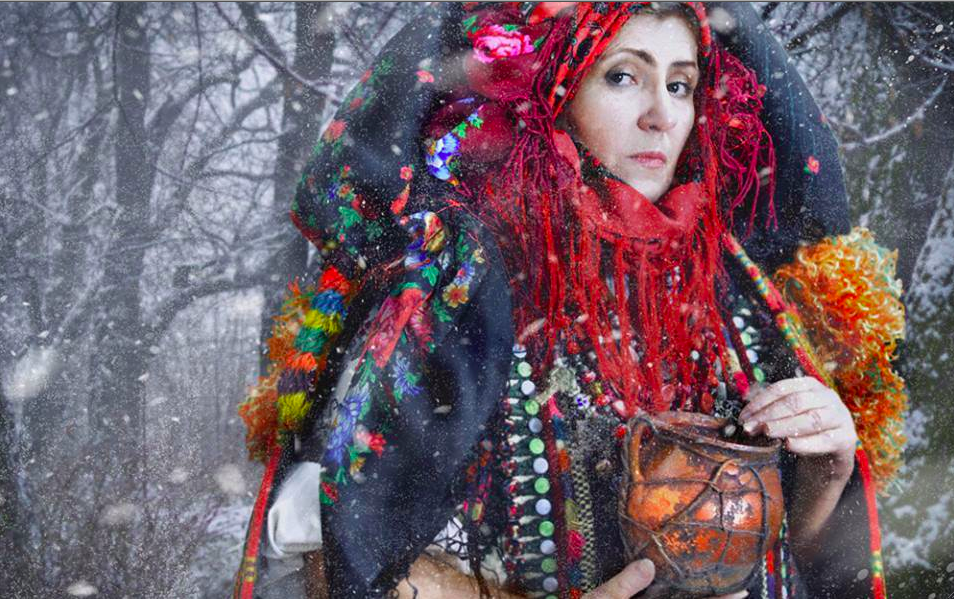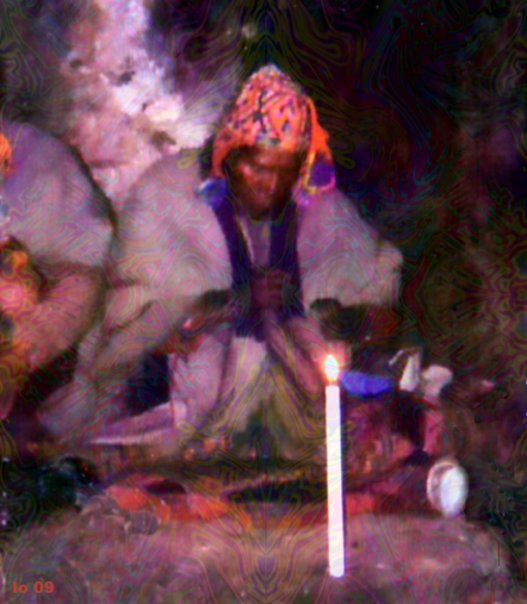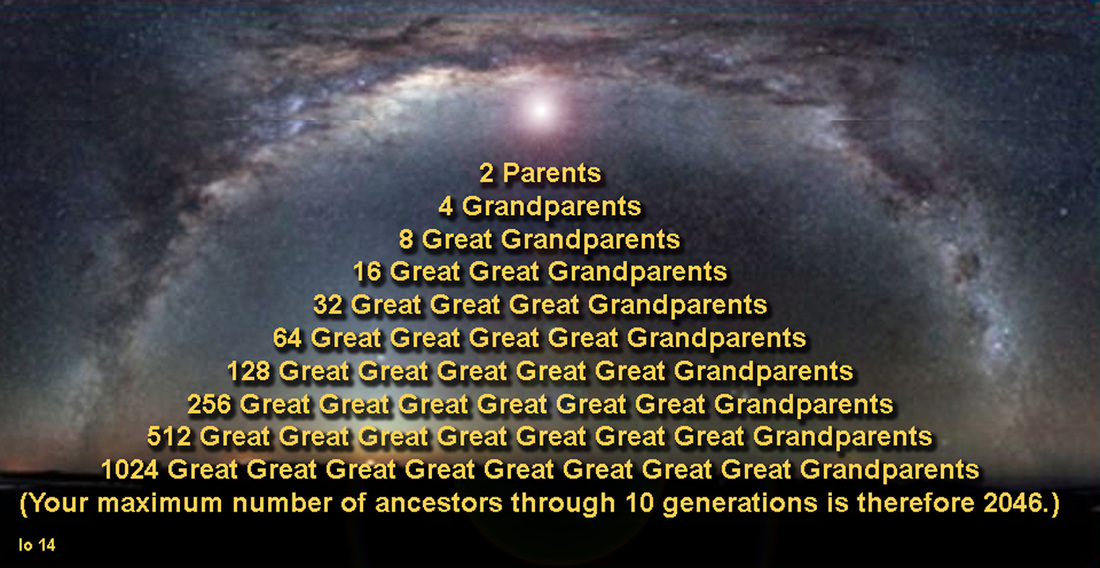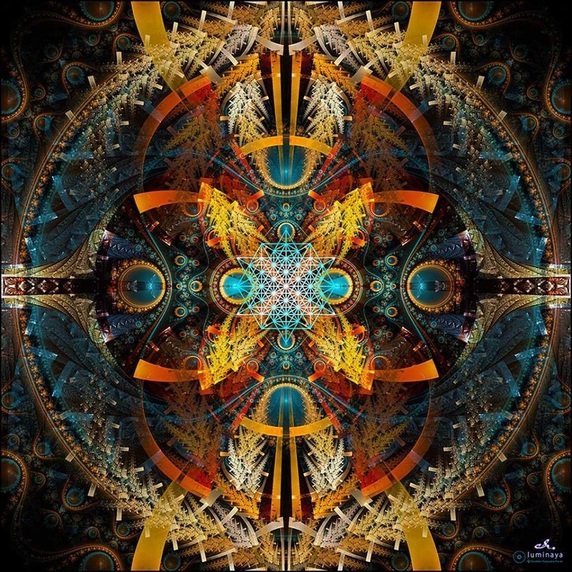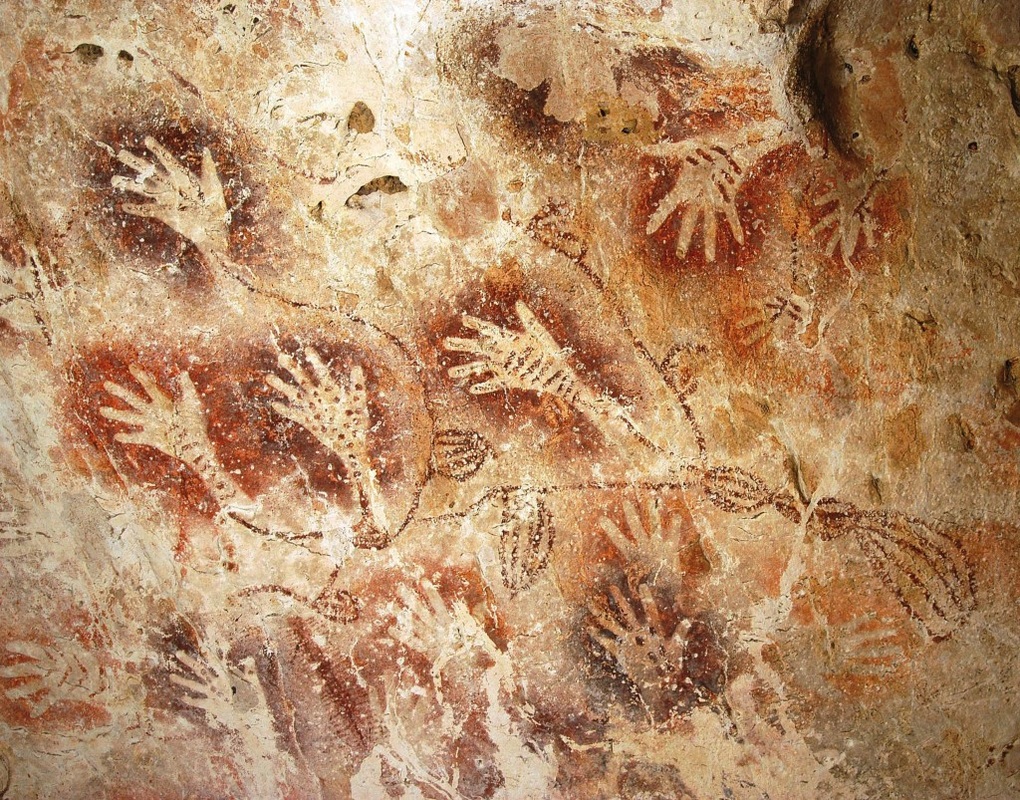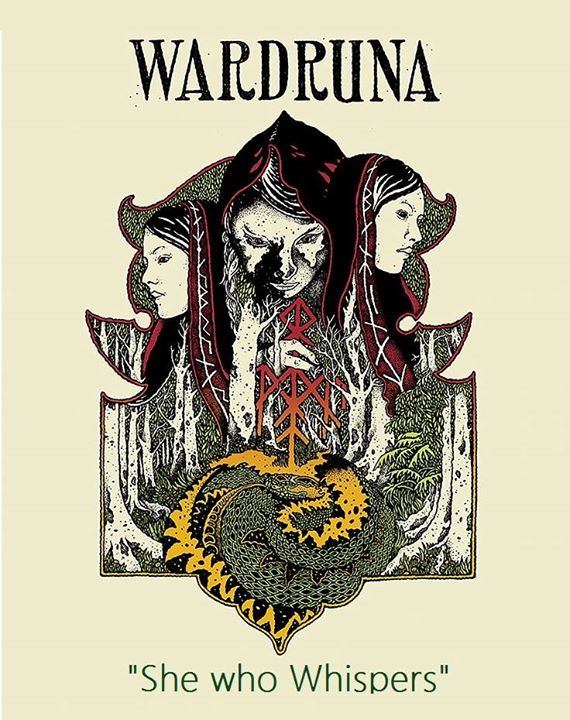Chapter 6
Bridge of Spirits;
The Call of Our Ancestors
SHAMANISM, GENEALOGY, & JUNG
by Iona Miller
Some of the most burdened family histories
require shamanic healing.
Bridge of Spirits;
The Call of Our Ancestors
SHAMANISM, GENEALOGY, & JUNG
by Iona Miller
Some of the most burdened family histories
require shamanic healing.
[Carl Jung on “Shamanism.”] From Dr. Jung 28 January 1913
With regard to your question concerning the applicability of the cathartic procedure, I can say that I adopt the following standpoint: every procedure is good if it helps.
I therefore acknowledge every method of suggestion including Christian Science, mental healing, etc. "A truth is a truth, when it works." It is another question, though, whether a scientifically trained doctor can square it with his conscience to sell little bottles of Lourdes water because this suggestion is at times very helpful.
Even the so-called highly scientific suggestion therapy employs the wares of the medicine-man and the exorcising shaman. And why not? The public is not much more advanced either and continues to expect miraculous cures from the doctor.
And indeed, we must rate those doctors wise—worldly-wise in every sense—who know how to surround themselves with the aura of a medicine-man.
They have not only the biggest practices but also get the best results.
This is because, apart from the neuroses, countless physical illnesses are tainted and complicated with psychic material to an unsuspected degree.
The medical exorcist betrays by his whole demeanour his full appreciation of that psychic component when he gives the patient the opportunity of fixing his faith firmly on the mysterious personality of the doctor.
In this way he wins the sick man’s mind, which from then on helps him to restore his body to health. The cure works best when the doctor himself believes in his own formulae, otherwise he may be overcome by scientific doubt and so lose the proper convincing tone. Carl Jung, CW 4, Pages 255-256
With regard to your question concerning the applicability of the cathartic procedure, I can say that I adopt the following standpoint: every procedure is good if it helps.
I therefore acknowledge every method of suggestion including Christian Science, mental healing, etc. "A truth is a truth, when it works." It is another question, though, whether a scientifically trained doctor can square it with his conscience to sell little bottles of Lourdes water because this suggestion is at times very helpful.
Even the so-called highly scientific suggestion therapy employs the wares of the medicine-man and the exorcising shaman. And why not? The public is not much more advanced either and continues to expect miraculous cures from the doctor.
And indeed, we must rate those doctors wise—worldly-wise in every sense—who know how to surround themselves with the aura of a medicine-man.
They have not only the biggest practices but also get the best results.
This is because, apart from the neuroses, countless physical illnesses are tainted and complicated with psychic material to an unsuspected degree.
The medical exorcist betrays by his whole demeanour his full appreciation of that psychic component when he gives the patient the opportunity of fixing his faith firmly on the mysterious personality of the doctor.
In this way he wins the sick man’s mind, which from then on helps him to restore his body to health. The cure works best when the doctor himself believes in his own formulae, otherwise he may be overcome by scientific doubt and so lose the proper convincing tone. Carl Jung, CW 4, Pages 255-256
Let’s start at the very beginning: What does a shaman do? A shaman is a person who becomes fully possessed by their ancestral or heavenly spirits. During this time, their soul exits their body (usually flying up to the heavens) and another spirit takes over their body. This spirit uses the body to communicate. They will speak, eat, drink, sing, smoke, conduct massage, even acupuncture, all through the body of their ulaach or medium. When the spirit is finished they will leave. The shaman’s soul will return to his or her body. He or she will have no memory whatsoever of what has occurred in this time.
First, you must have shamanic ancestry. This is blood lineage ancestry. It may be many generations back, but it has to be there. Your calling happens when the spirits choose you. Now STOP! This doesn’t mean you can say “Oh, the spirits chose me! I feel them around me!” Because that is not how it works! Go back home and find your own ancestral traditions. They are your birthright. You can follow them as much as you please.
http://upliftconnect.com/are-you-a-shaman/
First, you must have shamanic ancestry. This is blood lineage ancestry. It may be many generations back, but it has to be there. Your calling happens when the spirits choose you. Now STOP! This doesn’t mean you can say “Oh, the spirits chose me! I feel them around me!” Because that is not how it works! Go back home and find your own ancestral traditions. They are your birthright. You can follow them as much as you please.
http://upliftconnect.com/are-you-a-shaman/
Fertile Darkness
“The primitive magician, the medicine man or shaman is not only a sick man, he is above all, a sick man who has been cured, who has succeeded in curing himself.”
― Mircea Eliade, Shamanism: Archaic Techniques of Ecstasy
In Re-Visioning Psychology, James Hillman describes "the archetypal figure of the Wounded Healer, another ancient and psychological way of expressing that the illness and the healer are one and the same" (76). In the essay "Puer Wounds and Ulysses' Scar" in Senex and Puer, Hillman explains that the act of healing is not "because one is whole, integrated, and all together, but from a consciousness breaking through dismemberment" (234).
It would be frightening to think that in all the cosmos, which is so harmonious, so complete and equal to itself, that only human life is happening randomly, that only one's destiny lacks meaning. --Eliade, Attributed in The Little Book of Romanian Wisdom (2011) edited by Diana Doroftei and Matthew Cross.
“A medicine man shouldn’t be a saint. He should experience and feel all the ups and downs, the despair and the joy, the magic and the reality, the courage and fear of his people…You have to be God and the devil, both of them. Being a good medicine man means experiencing life in all its phases. It means not being afraid of cutting up and playing the fool now and then. That’s sacred too.”
— Alejandro Jodorowsky from Psychomagic
“The primitive magician, the medicine man or shaman is not only a sick man, he is above all, a sick man who has been cured, who has succeeded in curing himself.”
― Mircea Eliade, Shamanism: Archaic Techniques of Ecstasy
In Re-Visioning Psychology, James Hillman describes "the archetypal figure of the Wounded Healer, another ancient and psychological way of expressing that the illness and the healer are one and the same" (76). In the essay "Puer Wounds and Ulysses' Scar" in Senex and Puer, Hillman explains that the act of healing is not "because one is whole, integrated, and all together, but from a consciousness breaking through dismemberment" (234).
It would be frightening to think that in all the cosmos, which is so harmonious, so complete and equal to itself, that only human life is happening randomly, that only one's destiny lacks meaning. --Eliade, Attributed in The Little Book of Romanian Wisdom (2011) edited by Diana Doroftei and Matthew Cross.
“A medicine man shouldn’t be a saint. He should experience and feel all the ups and downs, the despair and the joy, the magic and the reality, the courage and fear of his people…You have to be God and the devil, both of them. Being a good medicine man means experiencing life in all its phases. It means not being afraid of cutting up and playing the fool now and then. That’s sacred too.”
— Alejandro Jodorowsky from Psychomagic
Shared Consciousness
They stand facing the past and their ancestors, who are a living presence in spirit. It is the vision of the ancestors that guides the present generation into the unseen future, with one clear and overriding purpose: to prosper the generations yet to be born. Our own ancestors practiced shamanism. We are all descendants of shamanic peoples.
Recognizing that the Earth and many of its creatures vastly predate humanity and are therefore possessed of much older wisdom, our forebears honored selected landforms, trees, plants, and animals as their ancestors. They understood that there is deep wisdom in the rhythms of the Earth and an infinite variety of life experience stored by our fellow creatures and by spirits. Human health and welfare were understood to depend on tapping into this wellspring of wisdom. On a planet that is everywhere alive, conscious and inspirited, humans were believed to have many wise allies for counsel and aid.
They stand facing the past and their ancestors, who are a living presence in spirit. It is the vision of the ancestors that guides the present generation into the unseen future, with one clear and overriding purpose: to prosper the generations yet to be born. Our own ancestors practiced shamanism. We are all descendants of shamanic peoples.
Recognizing that the Earth and many of its creatures vastly predate humanity and are therefore possessed of much older wisdom, our forebears honored selected landforms, trees, plants, and animals as their ancestors. They understood that there is deep wisdom in the rhythms of the Earth and an infinite variety of life experience stored by our fellow creatures and by spirits. Human health and welfare were understood to depend on tapping into this wellspring of wisdom. On a planet that is everywhere alive, conscious and inspirited, humans were believed to have many wise allies for counsel and aid.
Shamanism and Mystical Vocation
Since the beginning of the century, technologists have fallen into the habit of using the terms, "shaman," "medicine man," "sorcer," and "magician" interchangeably to designate certain individuals possessing magico-religious powers and found in all "primitive" societies. By extension, the shamanic terminology has been applied in studying the religious history of "civilized" peoples, and there have been discussions, for example, of an Indian, an Iranian, a Germanic, a Chinese, and even a Babylonian "shamanism" with reference to the "primitive" elements attested in the corresponding religions. For many reasons this confusion can only militate against any understanding of the shamanic phenomenon. If the word "shaman" is taken to mean any magician, sorcerer, medicine man, or ecstatic found throughout the history of religions and religious ethnology, we arrive at a notion at once extremely complex and extremely vague; it seems, furthermore, to serve no purpose, for we already have the terms "magician" or "sorcerer" to express notions as unlike and as ill-defined as "primitive magic" or "primitive mysticism."
Though the shaman is, among other things, a magician, not every magician can properly be termed a shaman. The same distinction must be applied in regard to shamanic healing; every medicine man is a healer, but the shaman employs a method that is his and his alone. As for the shamanic techniques of ecstasy, they do not exhaust all the varieties of ecstatic experience documented in the history of religions and religious ethnolgoy. Hence any ecstatic cannot be considered a shaman; the shaman specializes in a trance during which his soul is believed to leave his body and ascend to the sky or descend to the underworld.
You cannot call yourself a shaman;
Only the community can do that
"In shamanic traditions it is important that the person is not just understood as an individual, they are connected to a network in their society as well as connected to their family lineage. Ancestral healing is very important in shamanism. And they are discovering this through science as well, in the field of epigenetics, where we can see that we inherit our physical characteristics, but we also can inherit much more. We can inherit memories of trauma, and generations later this can be manifesting in our current lives. One of the journeys we do in shamanism is to journey back and meet our ancestors to discover the power of our lineage. We often think of the defects we may have inherited, but it is really important to travel back to discover the power that we have from our ancestors too. In all shamanic cultures, working with the ancestors is vitally important because we are the ancestors of future generations to come.
As a psychotherapist, I notice that there is often one member of the family that is carrying the family pathology and when they realise that and work through it, it is a systemic thing, and the system often moves on or changes when they do it – those people are usually the shamans or healers in the family. " --Martin Duffy
Holistic Approach to Grief
There are three absolute certainties in life – birth, change and death – and as human beings we seem to be terrified of all of them. When we grieve we are dealing with all three at the same time - the death of a loved one, the huge changes that inevitably brings and the birth of their new transition to spirit. Or it may be the 'ghost' of an unknown sibling. In olden times in Ireland there were very specific rituals and ceremonies to help the whole grieving process. However in our modern world many of these have been lost.
http://networkmagazine.ie/articles/grief-holistic-approach
Genetic Memory
Gathering Family Memories
In our collective quest, we resort to parish and other local registers, to testamentary documents, to the archives of public offices, to the records of nonconformist associations, to family papers, and to various collections of original manuscripts. We collect and share family memories at holidays and family gatherings. Yes, there will be unavoidable mistakes in the self-correcting process, but we do our best with available information. As the curated World Tree grows, more is available to us with less need to repeat the good work of others, though we adopt it cautiously.
Using genetic memories as a genealogical tool is probably taboo in conventional genealogy, but not as a shamanic or Jungian technique. Recognizing genetic memories and subtle leads may aid in your search for your ancestors. Wikipedia defines the psychological definition of genetic memories as "a memory present at birth that exists in absence of sensory experience."
The scientific explanation for genetic memories is through DNA transfer and epigenetics. We have the DNA of our ancestors in our genetic makeup. We do not have DNA from each line and each ancestor. Our female-donated mitochondrial DNA is inherited in a longer unbroken chain than the male Y-haplotype.
At about 360 years, or just short of 15 generations mtDNA peters out. At 15 generations, an individual living today would carry only three thousands of 1% (00.003052%) of the DNA of an ancestor who was “pure” anything 15 generations ago. So even if one ancestor was indeed Mediterranean or whatever 15 generations ago, unless they continuously intermarried within a pure Mediterranean population, the amount would drop by 50% with each generation to the miniscule amount that would be found in today’s current generation. With today’s technology, this is simply untraceable in autosomal DNA.
The fact that mitochondrial DNA is maternally inherited enables genealogical researchers to trace maternal lineage far back in time.
These memories can surface as anything from a musical or other talent without lessons of any kind to enjoying or detesting the same activities of an ancestor. This is NOT reincarnation, but does offer an explanation to why certain people find places, people or events familiar when there are no other explanations.
Many report that genetic memories seem to assist in your search for family history. At some point in doing genealogy, a little voice will whisper information is wrong. Or you may find yourself in a cemetery directly in front of the grave you were seeking without knowing beforehand where to look. This can be attributed to genetic memories. The DNA may guide you to extraordinary finds by listening to your inner voice. Something akin to Jung's notion of synchronicity may be at play. This enlivens the research process which provides the basis for such often uncanny experiences.
We may at times experience the pain of destruction of dearly-cherished traditions or offend those who have long prided themselves on what proves itself to be an entirely imaginary descent from some mythical ancestor, but the faithful genealogical historian must go forward
without fear or favor, secure in the panoply of truth.
For centuries such mythically-rooted accounts have been considered genealogical best-practice. And we can still honor that "as if" reality by approaching the material symbolically to discover and interact with even deeper layers of our psyche and collective inheritance. In this regard the works of Jung and his intellectual descendants can be invaluable.
In this way, we plumb our depths and secure a treasure of self-knowledge that transcends objective human history. Jung's wife, Emma made a life-long study of the meaning of the Grail; her work was completed by Marie-Louise von Franz. Gnosis is often found in the gaps of logical knowledge.
Since the beginning of the century, technologists have fallen into the habit of using the terms, "shaman," "medicine man," "sorcer," and "magician" interchangeably to designate certain individuals possessing magico-religious powers and found in all "primitive" societies. By extension, the shamanic terminology has been applied in studying the religious history of "civilized" peoples, and there have been discussions, for example, of an Indian, an Iranian, a Germanic, a Chinese, and even a Babylonian "shamanism" with reference to the "primitive" elements attested in the corresponding religions. For many reasons this confusion can only militate against any understanding of the shamanic phenomenon. If the word "shaman" is taken to mean any magician, sorcerer, medicine man, or ecstatic found throughout the history of religions and religious ethnology, we arrive at a notion at once extremely complex and extremely vague; it seems, furthermore, to serve no purpose, for we already have the terms "magician" or "sorcerer" to express notions as unlike and as ill-defined as "primitive magic" or "primitive mysticism."
Though the shaman is, among other things, a magician, not every magician can properly be termed a shaman. The same distinction must be applied in regard to shamanic healing; every medicine man is a healer, but the shaman employs a method that is his and his alone. As for the shamanic techniques of ecstasy, they do not exhaust all the varieties of ecstatic experience documented in the history of religions and religious ethnolgoy. Hence any ecstatic cannot be considered a shaman; the shaman specializes in a trance during which his soul is believed to leave his body and ascend to the sky or descend to the underworld.
You cannot call yourself a shaman;
Only the community can do that
"In shamanic traditions it is important that the person is not just understood as an individual, they are connected to a network in their society as well as connected to their family lineage. Ancestral healing is very important in shamanism. And they are discovering this through science as well, in the field of epigenetics, where we can see that we inherit our physical characteristics, but we also can inherit much more. We can inherit memories of trauma, and generations later this can be manifesting in our current lives. One of the journeys we do in shamanism is to journey back and meet our ancestors to discover the power of our lineage. We often think of the defects we may have inherited, but it is really important to travel back to discover the power that we have from our ancestors too. In all shamanic cultures, working with the ancestors is vitally important because we are the ancestors of future generations to come.
As a psychotherapist, I notice that there is often one member of the family that is carrying the family pathology and when they realise that and work through it, it is a systemic thing, and the system often moves on or changes when they do it – those people are usually the shamans or healers in the family. " --Martin Duffy
Holistic Approach to Grief
There are three absolute certainties in life – birth, change and death – and as human beings we seem to be terrified of all of them. When we grieve we are dealing with all three at the same time - the death of a loved one, the huge changes that inevitably brings and the birth of their new transition to spirit. Or it may be the 'ghost' of an unknown sibling. In olden times in Ireland there were very specific rituals and ceremonies to help the whole grieving process. However in our modern world many of these have been lost.
http://networkmagazine.ie/articles/grief-holistic-approach
Genetic Memory
Gathering Family Memories
In our collective quest, we resort to parish and other local registers, to testamentary documents, to the archives of public offices, to the records of nonconformist associations, to family papers, and to various collections of original manuscripts. We collect and share family memories at holidays and family gatherings. Yes, there will be unavoidable mistakes in the self-correcting process, but we do our best with available information. As the curated World Tree grows, more is available to us with less need to repeat the good work of others, though we adopt it cautiously.
Using genetic memories as a genealogical tool is probably taboo in conventional genealogy, but not as a shamanic or Jungian technique. Recognizing genetic memories and subtle leads may aid in your search for your ancestors. Wikipedia defines the psychological definition of genetic memories as "a memory present at birth that exists in absence of sensory experience."
The scientific explanation for genetic memories is through DNA transfer and epigenetics. We have the DNA of our ancestors in our genetic makeup. We do not have DNA from each line and each ancestor. Our female-donated mitochondrial DNA is inherited in a longer unbroken chain than the male Y-haplotype.
At about 360 years, or just short of 15 generations mtDNA peters out. At 15 generations, an individual living today would carry only three thousands of 1% (00.003052%) of the DNA of an ancestor who was “pure” anything 15 generations ago. So even if one ancestor was indeed Mediterranean or whatever 15 generations ago, unless they continuously intermarried within a pure Mediterranean population, the amount would drop by 50% with each generation to the miniscule amount that would be found in today’s current generation. With today’s technology, this is simply untraceable in autosomal DNA.
The fact that mitochondrial DNA is maternally inherited enables genealogical researchers to trace maternal lineage far back in time.
These memories can surface as anything from a musical or other talent without lessons of any kind to enjoying or detesting the same activities of an ancestor. This is NOT reincarnation, but does offer an explanation to why certain people find places, people or events familiar when there are no other explanations.
Many report that genetic memories seem to assist in your search for family history. At some point in doing genealogy, a little voice will whisper information is wrong. Or you may find yourself in a cemetery directly in front of the grave you were seeking without knowing beforehand where to look. This can be attributed to genetic memories. The DNA may guide you to extraordinary finds by listening to your inner voice. Something akin to Jung's notion of synchronicity may be at play. This enlivens the research process which provides the basis for such often uncanny experiences.
We may at times experience the pain of destruction of dearly-cherished traditions or offend those who have long prided themselves on what proves itself to be an entirely imaginary descent from some mythical ancestor, but the faithful genealogical historian must go forward
without fear or favor, secure in the panoply of truth.
For centuries such mythically-rooted accounts have been considered genealogical best-practice. And we can still honor that "as if" reality by approaching the material symbolically to discover and interact with even deeper layers of our psyche and collective inheritance. In this regard the works of Jung and his intellectual descendants can be invaluable.
In this way, we plumb our depths and secure a treasure of self-knowledge that transcends objective human history. Jung's wife, Emma made a life-long study of the meaning of the Grail; her work was completed by Marie-Louise von Franz. Gnosis is often found in the gaps of logical knowledge.
* THE BRIDGE OF SPIRITS
“When something long since passed . . . comes back again in a changed world, it is new. To give birth to the ancient in a new time is creation.” --Jung, Red Book
There is wisdom in the time-tested practices of other cultures. There is an innate human genius for healing. Shamanic medicine restores power, harmony and spirit. Your “inner shaman” is a guide or bridge between the physical world and the instinctual spirit world. It is also the bridge between the mind and body.
The shaman teaches how to live in harmony and balance with one another and the Earth. You and your family tree are a bridge to the spirits. Our shamanic journeys help us step outside confining personality and ego to “see” the soul and restore power and harmony. We may even transform death into greater life.
Cognitive & Emotional Unconscious
The shaman/therapist represents a hybrid or gestalt. We can combine powerful consciousness-altering rituals, worldviews, and shamanic visionary experiences with the techniques, theories, and practices of depth psychologies. The shaman/therapist is not just a simple mixing, or borrowing of techniques from one to the other, but a radical shift in worldview.
To have greater depth in healing you need two models or world-views operating simultaneously, much like you need two eyes for depth in visual perception. One eye is that of the scientist, analyst, therapist. The other eye is that of the shaman, mystic, spiritual healer. Both need to be operating at the same time for this depth to realize. This distinguishes it from the methods practiced in Transpersonal Psychology which were like alternately opening one eye and then the other.
Healing and disease are matters that involve senses more than mind and are matters of consciousness and its structures. Symptoms are at their base attempts by the organism to solve problems. As such their isolated eradication can result in further symptoms arising in answer to the unsolved deeper issue.
Consciousness prevails throughout all reality and is a basic field that is part of all structure. There are only self-healers, the best we can do is find and encourage that process in another.
Mind-body medicine begins with awareness. Ancient texts, like the Upanishads, tell us matter emerges from consciousness, while life, mind, and the creation come from that same consciousness/matter. Shamans hold a similar worldview, that beyond the “worlds” of matter and illusion lies a reality beyond our perception, containing the raw potential of all possible forms of material existence.
The mind is an active power that can manifest form out of the essence of the universe, both in the body and outside it. Psychoneuroimmunology and physics agree the mind of the observer affects results. An integrated medicine shuns superstition and metaphysics but understands the value of unknown psychic dynamics. Researchers like Candace Pert and Bruce Lipton have demonstrated the complex interaction of emotions, memory, and cellular function on the whole organism.
Our thoughts and feelings, our attitudes, and our expectations demonstrably affect the state of our immune system, rate of healing, responses to medications and procedures, and the various cycles and interactions going on within our bodies from moment to moment. We can overload our systems with stress to the point of disease induced by unconscious beliefs. Unconscious beliefs are embedded at the cellular level, and some of them are epigenetic -- that is, transgenerational.
*
Transgenerational Integration works across several generations.
The Transgenerational perspective maintains that generational conflict can remain unresolved through out generations. This view does not imply causation of conflict, only that unresolved issues can continue to affect families throughout generations.
Transgenerational trauma is trauma that is transferred from the first generation of trauma survivors to the second and further generations of offspring of the survivors via complex post-traumatic stress disorder mechanisms. Psychic legacies are often passed on through unconscious cues or affective messages that flow between child and adult. Sometimes anxiety falls from one generation to the next through stories told.
Transgenerational transmissions take on life in our in dreams, in acting out, in “life lessons” given in turns of phrase and taught us by our family. Discovering transmission means coming to know and tell a larger narrative, one from the preceding generation. It requires close listening to the stories of our parents and grandparents, with special attention to the social and historical milieu in which they lived -- especially its military, economic and political turmoil.
The emotional ties between child and ancestors are essential to the development of our values. These bonds often determine the answers to myriad questions such as: “Who am I?” "Who am I to my family?” “Who can ‘we’ trust” and who are our enemies?” “What ties me to my family?” And, most importantly, “of these ties, which do I reject and which to I keep?" (Barri Belnap, 127) In rising above the remnants of one's ancestors' trauma, one helps to heal future generations.
Transgenerational epigenetic inheritance is the transmittance of information from one generation of an organism to the next (e.g., parent–child transmittance) that affects the traits of offspring without alteration of the primary structure of DNA. The less precise term "epigenetic inheritance" may be used to describe both cell–cell and organism–organism information transfer. Transgenerational epigenetic inheritance is the idea that epigenetic marks (i.e., DNA methylation, histone modifications) can be acquired on the DNA of one generation and stably passed on through the gametes (i.e., sperm and eggs) to the next generation.
*
Every day we have an opportunity to die to our old programs and embrace new ones. As well as living, the work of our mortality involves paying fulfilling attention to death and dying. Armed with this, we can undertake the creation of a profound healing. Through and beyond the ego we access a profound and creative state of consciousness that provides our form and the core of our being.
We might start by simply preparing a place to honor the ancestors, perhaps where we will work on our genealogy. A simple ceremony is to call on the ancestors to activate your "shrine," and perhaps share a spiritual fear or other feelings.
This altar becomes the point of contact between to worlds. It is a physical declaration of your relationship with your ancestors. How much would you value a deeper understanding of your parents, grandparents, and great-grandparents? Are you willing to chase spirit to build lost family connections?
You don't have to become a healer or shaman to adopt the basic techniques. This is the focus for the heart-centered part of your work. It is a symbolic gateway you can open or close, should you choose. You may wish to make offerings or gifts. The next step is to amplify and deepen the process, and listen for their calls to you. You may simply be invisibly influenced in subtle ways, or have an intuition or crucial insight.
Indigenous societies consider death a transition to the land of the ancestors, but they remain part of the community. Not only our souls but our bodies contain age-old elements of the ancestors. The ancestors can be wise, and they can be supportive in the face of conflict. They remind us of our soul purpose. We might only have visceral responses, chills, or feel touched by the sacred.
We all have an innate ability to connect with our ancestors. They can contact us and we can contact them. We can also use active imagination, dialogue, interactive imagery, or meditation to initiate the process. We don't need to take such visitors literally, but we must take them seriously while maintaining our own values.
You don't need to become a ghost whisperer or anything like that. Just be open to the wisdom and blessings of those who've gone before. They may call through dream, or trance, or direct knowing. Or, we can use a simple "empty chair" dialogue, transgenerational psychodrama, or journaling technique to 'speak' to an ancestor, as if they were there.
We can draw images of our impressions of them. Perhaps a synchronicity or sign carries their essential message. They will guide your family healing as they want the line to thrive. As you renew these relationships they nourish you. You enliven them and live from your ancestral soul. Our animals souls are rooted in primeval ages.
Here, we create our healing from within. We experience first-hand that personal power (empowerment) arises from within. Hallmarks of the shamanic experience include The Journey, Spirit Guides, Otherworld, Shamanic Calling, Divination,
Sacred Precinct, Big Dreams, and Shamanic Awareness, including a cyclic worldview.
Travel to other worlds is often by means of a perceived ladder, tree or staircase, and the use of secret languages, taught by spirits who travel on the ladder.. Experience is more important than creed. Specific practices common across shamanic traditions include the following:
The Medicine Wheel, the circle of life, is a shamanic healing model. The magic circle is a synergy of chaos and order == a mythic model for creation and a device for magical orientation and protection. It functions like a homing device, calling us backward to our foundation and forward to the future.
As Hesse says in Steppenwolf, "We have no one to guide us. Our only guide is our homesickness." The Taoists call the center of the mandala, "the land of the ancestors." In Letters, Vol. II, Jung points out that paradoxically, "this center has to be created though it was always there."
This motif illustrates four phases in the healing process as 1) Initiation, threshold experience; arousal 2) Letting Go, surrender to process; conception 3) New Vision, connecting with power; gestation, 4) Actualization, integration; rebirth. Newly-learned skills and intuition are put into fruitful practice, connecting one to self, community, and Universe, restoring balance.
In Meaning and Medicine (1993), Larry Dossey, MD defines three eras of modern medicine. 1) Scientific medicine of symptom diagnosis and surgery; 2) mind-body medicine with active self-care, and 3) transpersonal medicine, focused on methods that connect people to their innate abilities to heal themselves and others. Shamanic therapies facilitate the transpersonal aspect. Transgenerational Integration is another transpersonal domain of healing.
In Process Meditation, Progoff (1982) offered some “Entrance Meditations” designed to open the experiential dimension. Such paradigms for self-inquiry facilitate therapeutic, meditative, and transformative experience. “The White-Robed Monk” begins as we enter through a door in a tree. Then we 'descend' to find the wisdom figure. Such twilight states are a trance that intentionally encourages exploration of the depth dimension.
Each us is the special door to our family tree. Progoff recommends journaling, too, and in some sense working the pedigree is like writing a transgenerational journal, especially if we use it in conjunction with a dialogue process. The personal narrative takes on a new dimension when it is extended to the family of the World Tree.
Narrative is a powerful form. In our genealogical work the story unfolds of itself. The main requirement is simply participation. Participatory wisdom is an emergent function. Hillman reminds us, "To heal the symptom, we must heal the person, and to heal the person we must first heal the story in which the person has imagined himself."
The universality of storytelling indicates it is not just social learning but reflects something deep-seated in our genes. Professor Daniel Siegel M.D. believes there is a neurological subplot of the well-made story involving the integration of the brain’s left and right hemispheres. Stories link the factual to the emotional, the specific to the universal, the past to the present. A psychological approach takes such imagery symbolically and metaphorically. A religious approach is usually more literal.
We carry our histories, as well as the whole history of humanity, with us into the present through our bodies. Our feelings and thoughts become manifest in our physical structure. The past is "sedimented" in the body -- that is, it is embodied in our very structure. Our bodies' sensory apparatus is the only way we experience the larger world. It is the medium through which we meet and respond to that world, feeling its reciprocal impact on us. Thus our symptoms can reflect our cultural as well as personal attitudes.
“When something long since passed . . . comes back again in a changed world, it is new. To give birth to the ancient in a new time is creation.” --Jung, Red Book
There is wisdom in the time-tested practices of other cultures. There is an innate human genius for healing. Shamanic medicine restores power, harmony and spirit. Your “inner shaman” is a guide or bridge between the physical world and the instinctual spirit world. It is also the bridge between the mind and body.
The shaman teaches how to live in harmony and balance with one another and the Earth. You and your family tree are a bridge to the spirits. Our shamanic journeys help us step outside confining personality and ego to “see” the soul and restore power and harmony. We may even transform death into greater life.
Cognitive & Emotional Unconscious
The shaman/therapist represents a hybrid or gestalt. We can combine powerful consciousness-altering rituals, worldviews, and shamanic visionary experiences with the techniques, theories, and practices of depth psychologies. The shaman/therapist is not just a simple mixing, or borrowing of techniques from one to the other, but a radical shift in worldview.
To have greater depth in healing you need two models or world-views operating simultaneously, much like you need two eyes for depth in visual perception. One eye is that of the scientist, analyst, therapist. The other eye is that of the shaman, mystic, spiritual healer. Both need to be operating at the same time for this depth to realize. This distinguishes it from the methods practiced in Transpersonal Psychology which were like alternately opening one eye and then the other.
Healing and disease are matters that involve senses more than mind and are matters of consciousness and its structures. Symptoms are at their base attempts by the organism to solve problems. As such their isolated eradication can result in further symptoms arising in answer to the unsolved deeper issue.
Consciousness prevails throughout all reality and is a basic field that is part of all structure. There are only self-healers, the best we can do is find and encourage that process in another.
Mind-body medicine begins with awareness. Ancient texts, like the Upanishads, tell us matter emerges from consciousness, while life, mind, and the creation come from that same consciousness/matter. Shamans hold a similar worldview, that beyond the “worlds” of matter and illusion lies a reality beyond our perception, containing the raw potential of all possible forms of material existence.
The mind is an active power that can manifest form out of the essence of the universe, both in the body and outside it. Psychoneuroimmunology and physics agree the mind of the observer affects results. An integrated medicine shuns superstition and metaphysics but understands the value of unknown psychic dynamics. Researchers like Candace Pert and Bruce Lipton have demonstrated the complex interaction of emotions, memory, and cellular function on the whole organism.
Our thoughts and feelings, our attitudes, and our expectations demonstrably affect the state of our immune system, rate of healing, responses to medications and procedures, and the various cycles and interactions going on within our bodies from moment to moment. We can overload our systems with stress to the point of disease induced by unconscious beliefs. Unconscious beliefs are embedded at the cellular level, and some of them are epigenetic -- that is, transgenerational.
*
Transgenerational Integration works across several generations.
The Transgenerational perspective maintains that generational conflict can remain unresolved through out generations. This view does not imply causation of conflict, only that unresolved issues can continue to affect families throughout generations.
Transgenerational trauma is trauma that is transferred from the first generation of trauma survivors to the second and further generations of offspring of the survivors via complex post-traumatic stress disorder mechanisms. Psychic legacies are often passed on through unconscious cues or affective messages that flow between child and adult. Sometimes anxiety falls from one generation to the next through stories told.
Transgenerational transmissions take on life in our in dreams, in acting out, in “life lessons” given in turns of phrase and taught us by our family. Discovering transmission means coming to know and tell a larger narrative, one from the preceding generation. It requires close listening to the stories of our parents and grandparents, with special attention to the social and historical milieu in which they lived -- especially its military, economic and political turmoil.
The emotional ties between child and ancestors are essential to the development of our values. These bonds often determine the answers to myriad questions such as: “Who am I?” "Who am I to my family?” “Who can ‘we’ trust” and who are our enemies?” “What ties me to my family?” And, most importantly, “of these ties, which do I reject and which to I keep?" (Barri Belnap, 127) In rising above the remnants of one's ancestors' trauma, one helps to heal future generations.
Transgenerational epigenetic inheritance is the transmittance of information from one generation of an organism to the next (e.g., parent–child transmittance) that affects the traits of offspring without alteration of the primary structure of DNA. The less precise term "epigenetic inheritance" may be used to describe both cell–cell and organism–organism information transfer. Transgenerational epigenetic inheritance is the idea that epigenetic marks (i.e., DNA methylation, histone modifications) can be acquired on the DNA of one generation and stably passed on through the gametes (i.e., sperm and eggs) to the next generation.
*
Every day we have an opportunity to die to our old programs and embrace new ones. As well as living, the work of our mortality involves paying fulfilling attention to death and dying. Armed with this, we can undertake the creation of a profound healing. Through and beyond the ego we access a profound and creative state of consciousness that provides our form and the core of our being.
We might start by simply preparing a place to honor the ancestors, perhaps where we will work on our genealogy. A simple ceremony is to call on the ancestors to activate your "shrine," and perhaps share a spiritual fear or other feelings.
This altar becomes the point of contact between to worlds. It is a physical declaration of your relationship with your ancestors. How much would you value a deeper understanding of your parents, grandparents, and great-grandparents? Are you willing to chase spirit to build lost family connections?
You don't have to become a healer or shaman to adopt the basic techniques. This is the focus for the heart-centered part of your work. It is a symbolic gateway you can open or close, should you choose. You may wish to make offerings or gifts. The next step is to amplify and deepen the process, and listen for their calls to you. You may simply be invisibly influenced in subtle ways, or have an intuition or crucial insight.
Indigenous societies consider death a transition to the land of the ancestors, but they remain part of the community. Not only our souls but our bodies contain age-old elements of the ancestors. The ancestors can be wise, and they can be supportive in the face of conflict. They remind us of our soul purpose. We might only have visceral responses, chills, or feel touched by the sacred.
We all have an innate ability to connect with our ancestors. They can contact us and we can contact them. We can also use active imagination, dialogue, interactive imagery, or meditation to initiate the process. We don't need to take such visitors literally, but we must take them seriously while maintaining our own values.
You don't need to become a ghost whisperer or anything like that. Just be open to the wisdom and blessings of those who've gone before. They may call through dream, or trance, or direct knowing. Or, we can use a simple "empty chair" dialogue, transgenerational psychodrama, or journaling technique to 'speak' to an ancestor, as if they were there.
We can draw images of our impressions of them. Perhaps a synchronicity or sign carries their essential message. They will guide your family healing as they want the line to thrive. As you renew these relationships they nourish you. You enliven them and live from your ancestral soul. Our animals souls are rooted in primeval ages.
Here, we create our healing from within. We experience first-hand that personal power (empowerment) arises from within. Hallmarks of the shamanic experience include The Journey, Spirit Guides, Otherworld, Shamanic Calling, Divination,
Sacred Precinct, Big Dreams, and Shamanic Awareness, including a cyclic worldview.
Travel to other worlds is often by means of a perceived ladder, tree or staircase, and the use of secret languages, taught by spirits who travel on the ladder.. Experience is more important than creed. Specific practices common across shamanic traditions include the following:
- turning off “normal” thought processes to become silent inside,
- then listening to the body and the environment
- learning to manage the sensations and activities of the body
- study of the culture’s traditions that explain how the world works
- and how people’s minds, bodies, and communities function and develop
- study of one’s own thought processes, dreams, and imaginations
- use of specific movements and sounds to enhance awareness,
- physical strength and agility, and overall wellbeing
- perceptual training to learn to “see”
- and “feel” energy shifts in the body and the community
- use of various movements, mental discipline, breathing, substances,
- and other methods for achieving altered states of consciousness in which awareness moves beyond the range of normal senses, space, and time.
The Medicine Wheel, the circle of life, is a shamanic healing model. The magic circle is a synergy of chaos and order == a mythic model for creation and a device for magical orientation and protection. It functions like a homing device, calling us backward to our foundation and forward to the future.
As Hesse says in Steppenwolf, "We have no one to guide us. Our only guide is our homesickness." The Taoists call the center of the mandala, "the land of the ancestors." In Letters, Vol. II, Jung points out that paradoxically, "this center has to be created though it was always there."
This motif illustrates four phases in the healing process as 1) Initiation, threshold experience; arousal 2) Letting Go, surrender to process; conception 3) New Vision, connecting with power; gestation, 4) Actualization, integration; rebirth. Newly-learned skills and intuition are put into fruitful practice, connecting one to self, community, and Universe, restoring balance.
In Meaning and Medicine (1993), Larry Dossey, MD defines three eras of modern medicine. 1) Scientific medicine of symptom diagnosis and surgery; 2) mind-body medicine with active self-care, and 3) transpersonal medicine, focused on methods that connect people to their innate abilities to heal themselves and others. Shamanic therapies facilitate the transpersonal aspect. Transgenerational Integration is another transpersonal domain of healing.
In Process Meditation, Progoff (1982) offered some “Entrance Meditations” designed to open the experiential dimension. Such paradigms for self-inquiry facilitate therapeutic, meditative, and transformative experience. “The White-Robed Monk” begins as we enter through a door in a tree. Then we 'descend' to find the wisdom figure. Such twilight states are a trance that intentionally encourages exploration of the depth dimension.
Each us is the special door to our family tree. Progoff recommends journaling, too, and in some sense working the pedigree is like writing a transgenerational journal, especially if we use it in conjunction with a dialogue process. The personal narrative takes on a new dimension when it is extended to the family of the World Tree.
Narrative is a powerful form. In our genealogical work the story unfolds of itself. The main requirement is simply participation. Participatory wisdom is an emergent function. Hillman reminds us, "To heal the symptom, we must heal the person, and to heal the person we must first heal the story in which the person has imagined himself."
The universality of storytelling indicates it is not just social learning but reflects something deep-seated in our genes. Professor Daniel Siegel M.D. believes there is a neurological subplot of the well-made story involving the integration of the brain’s left and right hemispheres. Stories link the factual to the emotional, the specific to the universal, the past to the present. A psychological approach takes such imagery symbolically and metaphorically. A religious approach is usually more literal.
We carry our histories, as well as the whole history of humanity, with us into the present through our bodies. Our feelings and thoughts become manifest in our physical structure. The past is "sedimented" in the body -- that is, it is embodied in our very structure. Our bodies' sensory apparatus is the only way we experience the larger world. It is the medium through which we meet and respond to that world, feeling its reciprocal impact on us. Thus our symptoms can reflect our cultural as well as personal attitudes.
SHAMANISM MEETS GENEALOGY
Ancestors of the Dreamtime
We can imagine our genealogy in 2 or 3 dimensions:
The difference between the two kinds of thinking struck me a long time ago, and for my domestic use I have described the first kind as two-dimensional and the second kind as three-dimensional. ~Carl Jung, Letters Vol. II, Pages 481-482
Shamanism has become part of the conversation about healing and spiritual development. Ancestral spirits are a foundational part of this worldview. Shamanic healing has a pattern or steps -- a sequence of inner healing no matter what the outer form, including traditional medical practice. These phases include:
1) the pilgrimage;
2) the confession;
3) purification;
4) the offering;
5) dream quest;
6) dreamhealing;
7) work on dreams;
8) re-entry or integration.
The entire process is contingent on a healing sanctuary, whether that refuge can be found without or within. Processing is the principle of assisting an individual to look at his own existence, and improve his ability to confront what he is and where he is for greater adaptability, wholeness, and health.
THE PILGRIMAGE
The pilgrimage satisfies the necessary first step in healing. It is important because one commits one's energies and resources to healing. It is a notice of intent. The outcome of the process is directly proportional to the personal energy put into it, as well as the intent.
As in ancient times, the refuge, retreat, or sanctuary is a place where the seeker can devote all of their energy to their dreams and healing without worry about the outer world. That sense of safety is a key factor in healing, because healing is an act of trust. Sanctuary is being in a state of total safety which supports trust.
Healing involves pushing past old boundaries and negating old confining belief systems and that too is best done in trust and safety. Disease is a state of deep inner fear and pain, and it is easier to face fears and pain from a base of safety. Most therapists know this, but generally conceive of it as a pleasant office, confidentiality and being game and script free.
But it takes more--a deep respect and honoring of the natural healing process from within, rather than egotistically claiming to be "the healer." Dreams and visions seem so fragile, so whimsical, and insubstantial in our pragmatic, materially oriented society. When the substantial and concrete is valued more than the mystical and insubstantial it is more difficult to validate one's own inner life.
This is perhaps one reason the retreats were located a distance from any city. To live and survive in the civilized world requires a well-structured, strong ego and intellect just to deal with its technological complexity and its threat to our sense of self.
But the ego, in defending itself often feels and acts directly opposite to our deeper wisdom. In a word, we go against ourselves, a case of ego vs. higher self. This creates a state of tension or dis-ease which eventually manifests throughout our whole organism as mental and physical diseases that assume the shape of this inner conflict.
For example, most of us have a deep and basic fear and unease over how we are impacting our planet's ecosystems. We may or may not be aware of it, depending on our vested interests and whether or not we identify as environmentalists, but it is there.
Yet, in our daily battle to survive we burn fossil fuel driving to work in automobiles that deplete resources and generate pollution. We support hundreds of other activities daily that similarly degenerate the ecosystem. This deeply distresses, puts part of us out of ease with ourselves.
We are torn in opposite directions by the pulls of our survival instincts. It may be out of our awareness but we are distressed by it. Similarly, a person may continue to smoke cigarettes fully aware of the building health risks incurred. The fear of cancer may remain subconscious, but it exists, nevertheless.
Most degenerative diseases reflect this state of distress. Degenerative is also a word that characterizes what is happening to the ecosystem. For example, cancer is both a symbol and a physical manifestation of our existential conflict.
We could describe cancer as living cells in a state of uncontrollable growth destroying their host organism. This is a perfect metaphor for our relationship as a species to the ecosystem. Aerial photographs of cities bear a remarkable likeness to photographs of microscope slides of cancer cells. The outer disease assumes the shape of the inner state of dis-ease.
Nature and wilderness, however, invite flow and merging of the spirit and soul with the ego. Nature's threats are not to the ego or self alone, but to the entire organism. They require instinctual or intuitive responses involving the whole organism. This allows the ego self and the deeper instinctual self to cooperate in a dynamic balance and that fosters ease.
That, plus the beauty and serenity of wilderness, takes us back to our grounding-founding state. Nothing has the ability to return harmony to soul and ego so readily as nature. The nature-mystic experience is one of the most easily accessed non-ordinary states. Untainted wilderness is possibly one of the least realized yet most valuable healing resources that we have. Water, in particular, was important to the dream temples, and there was always a healing spring within the precinct.
THE CONFESSION
The confession helps you target where in your life you have missed the mark. The word "sin" is simply an old Greek archery term (hamartia) for "missing the mark." So if you miss, you simply try again. This self-analysis goes beyond an intellectual review of wrongs, should and ought-tos. It is a special form of in-sight. It signifies attention is turning inward, and becoming reflective.
Dreamhealing begins with the premise that each feature of the dream is a part of the dreamer. One can enter a symbol and speak as if one were that symbol and learn a lot about perspectives other than the ego. It is a way to experience the multiplicity of consciousness within each of us.
Many ego parts exist in states of conflict or dis-ease with each other, and by experiencing or becoming the symbols in a dream, and exploring the relationships among them, one eventually can resolve, or move beyond the rifts to a 'gestalt' or inner merging. This signifies the unification of conflicting parts into a state of wholeness or integrity.
This is a very healing experience for the ego. Occasionally in Gestalt dreamwork, the therapist-client team slips past the experience of the symbol to some deeper state of consciousness. These are confusing initially, because they don't compute with traditional training or experience, but they are intriguing.
If you merely forage deeper into the dreams, following the dream symbols through and beyond the surface features, they function as doorways into profound states of consciousness, very healing states of consciousness. There are apparently extremely powerful energies or forces within dreams. Just getting to them and experiencing them leads to profound healings.
What is really amazing is that they seem to have effects on physical levels, resulting in physical as well as mental restructuring of self image. Perhaps someday we can devise experiments to track these processes with biofeedback. It may eventually become possible to monitor physiology and feedback the unique pattern of mental and physical states that promote healing on an individualized level.
The confession is an extremely important part of the healing and letting-go process. The Asklepians believed that you couldn't be healed or visited by the god Asklepios until you were at ease with your own soul. Paralleling that practice, the confessional during a retreat is more a case of exploring the state of disease at many levels and from many perspectives.
It usually ends up looking more like psychotherapy. The physical and emotional diseases reflect or manifest inner states of dis-ease between ego-personal self and the deeper soul-self, or among the separate parts of the ego.
Identifying these out-of-ease states is the purpose of the psychotherapy-like confessional. It is a process of becoming more aware of and intimately acquainted with the disease and one's relationship to it on a very personal level.
Harking back to the meaning of sin as simply missing the mark, you have missed where you have sinned. So if you sin, try again with another arrow to reach your target. This is a closed-loop feedback system. It is important for the individual to actually hear their own voice identifying the problem area.
Another aspect of a psychotherapeutic confessional is that you also have the opportunity to declare and validate out loud, to yourself and others, what you have done right. Often in life this simple validation is unavailable or overlooked.
We all need a pat on the back once in a while for our growth and well being. Willingly taking time to self-reflect on one's positive and negative aspects promotes being honest with yourself. It implies taking personal responsibility in the sense of recognizing your personal ability to respond.
The dream guide functions in a manner similar to that of the ancient dream priest who oversaw the dream temples. A guide helps you make a trip through unfamiliar territory. They help you prepare for the trip and guide you to the best routes, but they don't take the trip for you -- they just provide the guidance.
The therapist's role, like the shaman of old, is to lead people on journeys deep into the unfamiliar terrain of the self and to the balancing states of consciousness that ease or heal. This is likely what the dream priests did. The word "priest" had different connotations to the Greeks than us.
The role of the Asklepian priest was to prepare, and guide the seekers to meet the healing god in the dream. They don't claim to be, or to speak for (channel), or interpret (analyst) the god. They simply guide each individual to their own personal encounter.
PURIFICATION
Purification prior to entry into sacred ground or sacred space has always been a priority in all forms of magic. And, make no mistake, the ancient technique was a form of magic with its own protocols. Today we can use a sweatlodge or sauna to purify through sweat and heat, a spa for water purification, and a healthy diet of natural foods. Most of these are easily available.
If dreamhealing is used in a traditional setting, the client may take a ritual bath, perhaps with herbs, before arriving for the session. It is a symbolic gesture of intent, and sets the tone that one is on a sacred mission with a higher aim in mind. Both purification and confession imply relieving oneself of sin. These practices also help reduce the stress of modern life. Purification of mind and spirit can be an important symbolic part of the process, preparing one for transformative challenge and change.
When it comes to purifying the body, the cleansing needs to be literal. Most people's bodies are filled with poisons, pesticides, preservatives and other anti-life chemicals in food. Nearly all meat is full of steroids and antibiotics, and even amphetamine residues used in chicken-raising.
A more natural diet cleans up the body chemistry. As you truly come to love yourself, you desire only the best for yourself both inside as well as outside. Some people use exercise, music, or drumming, and dancing partly as catharsis to clear out old emotional baggage. What is most important is not the form of the purification but letting the creative process flow to take whatever form is appropriate for the individual.
THE OFFERING
The dreamhealing offering may also take many forms. The most surface level, of course, involves dealing with paying fees for your therapeutic sanctuary. It has ever been so, since the days of the temples. In fact, the Greeks believed that stinting on this offering could jeopardize the healing.
Ceremonial offerings invoke a deeper and more personal commitment. Sometimes we create a more formal personal offering ceremony for individuals on retreat. But the offering happens at many levels, ceremonial or not.
During a ceremony, the seeker at some point is asked to offer something of themselves to help induce a healing dream. It is another personal energy commitment to healing, like the pilgrimage. For example, one might offer to devote time to working with the homeless, or commit to picking up three pieces of litter everyday, or some other form of community service. This offering is committing to give some form of service beyond one's self for the collective good.
The offering places even more value on the healing. It helps satisfy or ease the soul-ego conflicts. Further, following through on the offering puts ongoing energy into the healing process to prevent the dis-ease creeping back. Healing is a mind or mindful journey and so you have to help the mind to prepare and execute it. The offering helps invoke that state of mind.
DREAM QUEST
Our ancestors live in the Dreamworld. They may come to us spontaneously or through our therapeutic journeys. Some people like to use lucid dreaming to make a connection -- but remember, dreamlife is one last place where ego does not intrude on our imagination. So, tread lightly.
A "dream journey" uses the mind, in the broader concept of mind, to enter one's healing states. States of mind or consciousness can manifest, for example, as the "placebo effect" in medical terminology -- or in the evangelist's terms, faith healing.
It is a journey to our ultimate creative state of mind which is the source of our dreams and imagination. If you are so minded you might even consider this state to be "the Creator," "Higher Power," or "God force" within. In Jungian terms it would mean an experience of the healing power of the Self.
Healing is an act of creation, and that part of us, our creative spirit or the god within, speaks most vividly through dreams and imagination. Even Einstein considered imagination more important than knowledge. It is not an anti-scientific approach to dream.
A dream is a mystical expression of imagination and creative mind which is what ritual and ceremony help invoke. There is safety in ritual and ceremony--secureness in it. It is another symbolic act of commitment to an inner faith.
Ceremony by-passes the mind or intellect; it boggles it. It is a way of opening to a state of grace or faith, and these are integral aspects of mystical healing. Ceremony reminds you of something you already have within you, but don't usually notice. It brings it to surface awareness.
Because ceremonies are not rational, they confuse the rational mind. They appeal to the senses and take us outside of our usual ego experiences and beyond the experience of the rational or intellectual ego mind. This is where you find these healing states of consciousness, beyond the rational ego mind, in the mystic.
Any time you turn your attention within and become receptive to yourself you enter a whole new world of experience, which is just as real in effects as the outer world. You can facilitate change within yourself and cooperate with your personal growth or evolution. The only problem is getting around the habitual ego identity with its resistances to change.
Many techniques of hypnotherapy have been used for years to accomplish this. One of the more famous, the "confusion" technique was popularized by therapist Milton Erickson, a pioneer in modern hypnotic therapy. Any momentary disequilibrium of either the mind or body can induce a trance state which by-passes the conscious censoring ego and creates receptivity in the subconscious.
The ego mind is formed from the sum accumulation of our life's experiences and our reactions to them. It sets the limits or boundaries of our usual thing-feeling-behaving patterns. Based on our experiences, at deep levels of mind we form multi-sensory images of self and world -- images that capture their essence and shape our belief systems which in turn shape our ego and personality.
Not only do these primal sensory energy images and beliefs limits us, they also contain the "psychic" distortions which form the nuclei of our dis-eases. This structure is the ego-mind. It is limited, but what lies beyond is infinite mind or consciousness. It is our source of energy for re-imagining ourselves and healing.
New or unfamiliar experiences, irrational ones like ancient dream rituals that don't compute or match with your normal experiences cause confusion and disorientation in the ego-mind, and can even turn it off. In fact, most of the techniques used in dream guiding are based on fooling this part of the mind.
In ceremony, the ego either automatically or voluntarily steps aside and becomes willing to relinquish its fantasy of "control." It becomes more vulnerable and open, particularly if the environment is safe and supportive. This is when the deep wisdom, the collective infinite consciousness tapped into through dreams and visions helps transform the old beliefs and images into more ease-ful, less limiting ones. Then one opens to free and easy states of mind.
A healing retreat creates a different world image, one in which the inner mystical experiences, dreams and visions, are held to be equally, if not more important than outer processes. With sanctuary one is free to explore them -- the permission is there in the environment.
Virtually all religious traditions throughout recorded history held that the deities communicated with mortals through dreams and visions. Yet, direct communication with deity is a new, unsettling thought for many people. These experiences are neither encouraged nor allowed in our culture by its healing and religious institutions.
DREAMHEALING
Healing doesn't happen with a one or two time workshop, nor will one dream accomplish it entirely. Great progress comes in the initial stages occasionally, but it is not probable and most likely will only be symptomatic healing. Deep healing or restructuring takes a full commitment of self, time, and energy.
Most disease has taken years, perhaps a lifetime to develop and permeate all levels of our organism. By the time it takes on physical or emotional symptoms, it has been around for awhile and involves the whole person and most of their life patterns.
There is a momentum to each life and that is not usually changed overnight. It might not take three months, or it may take longer. Still, a retreat gives a person time and sanctuary and a better chance to explore themselves thoroughly to make deep physical and mental changes, to change the momentum.
In ancient Greece, the dream priest would look for a sign of the god in dreams. If they saw a sign of the god, then that was a sign that the healing had already occurred. Then you simply paid your fee for the upkeep of the temple, and left. As therapists, we can't say, "Oh, there is a snake in your dream--you've been healed--see you later." The ancient healings may have been conducted in this manner, but it is not necessarily enough for the modern ego, because it is a surrender of personal power to an external force which only visits in certain dreams.
Dreamhealing participants learn to realize that they are really the power behind their healing, not the therapist. That is much more empowering, and real healing is an empowering process, an opportunity for personal evolution. Knowledge of self-healing capacities goes back over the millennia.
That is a fundamental way dreamhealing differs from the ancient technique, or for that matter, most modern medical or new age healing practice. Common to shamanism, psychology, and the medical approaches are their implications that the healing power is outside of the person seeking healing. Somehow it is the doctor or his medicines and techniques, the shaman or the God -- someone, something, or somepower outside of the self who provides the healing. That disempowers.
WORK ON DREAMS
Bringing the awareness or senses of the inner healing process from the dream into the conscious or rational mind, which is what a dream journey does, helps us to realize the healing in the outer world also. It draws the ego-mind into a partnership of cooperation to make outer changes in lifestyle and behavior that compliment or support the inner ones. The individual is empowered and takes a more active -- pro-active -- role. The pattern is learn, commit, do.
Dream therapy often triggers surprising changes in life patterns without intellectual awareness of how the change of attitude occurs. For example, some dreamhealing participants find they are simply unable to eat certain foods, or lose the desire to smoke after a dream session, even though the work didn't touch on that at all.
It often takes the mind weeks or months to finally understand the depths and changes in personal dynamics that the dream therapy initiates. But it is still an inner process. We could describe it as intellect catching up to wisdom.
So, dreamhealing incorporates and expands on Asklepian dreamhealing. It was not derived from or contrived to fit this archetypal model. It emerges spontaneously, reiterating the same themes, loud and clear. It is a new paradigm for healing, a model that incorporates the old but only as part. It integrates science and mysticism yielding a view beyond the capabilities of either system alone.
Dreams themselves, as the long-forgotten healers, do this. From the scientific side, there has been much research and acknowledgement that dreams are necessary to health. They are believed to exert a balancing effect, and without them we soon show signs of mental and physical deterioration.
For example, studies have shown that sleep deprivation within days results in extreme nervousness and anxiety, hallucinations, or delusions. Freud, Jung, and Fritz Perls were among the earliest contemporary scientists who recognized the healing potential in dreams and used them as therapeutic tools, but they did so more from the superficial ego and interpretive levels.
Jung hinted at much deeper aspects of dreams, but still remained interpretive in his dream therapy. Perls recognized that it was the experiences in the dream that were healing, but limited it to the ego. Most "in depth" psychotherapies include dream therapy. And, of course, from the mystical perspective dreams come from the deities, and give us the gifts of prophecy, wisdom, and their unique perspective.
By and large, dreams are the forgotten healer. When healing is needed, very few people think of turning to their dreams.
RE-ENTRY
Dreams provide a missing feminine element as contrasted with the characteristically masculine approach in the medical healing model. It is an intuitive one where the person needing healing is acted on from the outside by therapists, chemicals, surgery, or technology. Dreams, on the other hand, are a personal inner healing, a non-intrusive one that arises from within, a creative healing of faith.
Modern medicine is practiced in bright lights and technically outfitted hospitals. Dreams are the night's creations from the soul and sleep. The contrast is that of a masculine quality, with a feminine quality.
This doesn't mean dreams should necessarily replace allopathic healing; they provide a balance and wholeness it is missing -- the yin and yang complementing the whole. It is a marriage between dreamhealing and medical science that seems most appropriate.
Dream therapy in hospitals might speed recovery rates from surgery and other medical techniques and treatments. It would certainly empower patients with a sense of personal and deep participation in the healing process.
For the skeptic, who wonders how ancient practices like Aesculapian mythology could play a role in our lives today, we suggest an open-mindedness about dreams. We can learn from them without having to become "true believers."
A new paradigm for healing has to incorporate all the models, but not be bound or limited to them. This includes the old and new medical technology, psychology, Aesculapian dreamhealing, shamanism, and anything else with something to offer. But it needs to be much more than just the sum of all of them.
The old models are incomplete and inadequate, too limited and narrowly focused. They are entrenched in dogma and habitual ways of viewing reality, and the patient.
Contemporary medical or psychological therapies, perhaps even more so than the ancient practices, are biased belief systems. Immediate change is imperative because, for starters, we need to heal our species' relationship with its environment. It is one of dis-ease.
None of the old models motivates us or shows us how to heal it--creativity will be required. Healers cannot just focus on only healing parts of the individual any more, the issues are much broader. The survival of our species is at stake.
*****
There is a traditional wisdom saying: “to forget one’s ancestors is to be a tree without a root.” Combining personal, familial, and collective talents can transform our destiny by analyzing and integrating familial patterns.
Jung points our in Modern Psychology that "Homer in his "Odyssey", Pythagoras, Orpheus, and later Goethe in his "Faust" all speak of journeys to the underworld." Like Orpheus, an old shamanic tale, we may make heroic efforts to collect our dead only to have them slip through our fingers back into the unconscious.
.If Orpheus is guardian of the sacred arts, then it is possible that never before has there been a century so much in need of his song. This is because the world insists, on a daily basis, that we lose ourselves rather than commune with loss, to be drawn to darkness as logos rather than seek out its mythos. The myth of Orpheus has an integral role today in that it returns us and brings us back into communion with the sacred through poetry, dance, music and art. (Lisa Jacobson, A Shrine for Orpheus)
For Odysseus, death meant perpetual imprisonment in the dark. But, we remain in the unconscious darkness if do not travel to the Underworld and face our mortality and the fate of the soul. Some of us, like Orpheus may not be able to retrieve much, but that is a story, too, and our fate. We may glimpse a line we would love to pursue only to find it an oft-repeated error or even forgery. We are forced back onto other ways through our family labyrinth. If we are lucky we find an underground stream of forgetfulness or remembrance to guide us back to the Source.
Shamanic Approach to Genealogy
Shamanic medicine restores power, harmony and spirit. Your “inner shaman” is a guide or bridge between the physical world and the spirit world. Our shamanic journeys help us step outside confining personality and ego to “see” the soul and restore power and harmony.
The shaman/therapist represents a hybrid or gestalt. We can combine powerful consciousness-altering rituals, worldviews, and shamanic visionary experiences with the techniques, theories, and practices of depth psychologies. The shaman/therapist is not just a simple mixing, or borrowing of techniques from one to the other, but a radical shift in worldview.
As well as living, the work of our mortality involves paying fulfilling attention to death and dying. Armed with this, we can undertake the creation of a profound healing. Through and beyond the ego we access a profound and creative state of consciousness that provides our form and the core of our being.
Here, we create our healing from within. We experience first-hand that personal power (empowerment) arises from within. Hallmarks of the shamanic experience include The Journey, Spirit Guides, Otherworld, Shamanic Calling, and Shamanic Awareness, including a cyclic worldview.
The Medicine Wheel, the circle of life, is a shamanic healing model. Its synergy of chaos and order is a mythic model for creation and a device for magical orientation and protection. It functions like a homing device, calling us backward to our foundation and forward to the future. As Hesse says in Steppenwolf, "We have no one to guide us. Our only guide is our homesickness."
This motif illustrates four phases in the healing process as 1) Initiation, threshold experience; arousal 2) Letting Go, surrender to process; conception 3) New Vision, connecting with power; gestation, 4) Actualization, integration; rebirth. Newly-learned skills and intuition are put into fruitful practice, connecting one to self, community, and Universe, restoring balance.
In his Process Meditation, Progoff (1982) offered some “Entrance Meditations” designed to open the experiential dimension. Such paradigms for self-inquiry facilitate therapeutic experience, meditative experience, and a transformative experience. “The White-Robed Monk” begins as we enter through a door in a tree. Then we 'descend' to find the wisdom figure. Such twilight states are a trance that intentionally encourages exploration of the depth dimension.
Our family tree is our special door in a tree. Progoff recommends journaling, too, and in some sense working the pedigree is like writing a transgenerational journal, especially if we use it in conjunction with a dialogue process. The personal narrative takes on a new dimension when it is extended to the family of the World Tree.
Narrative is a powerful form. In our genealogical work the story unfolds of itself. The main requirement is simply participation. Participatory wisdom is an emergent function. Hillman reminds us, "To heal the symptom, we must heal the person, and to heal the person we must first heal the story in which the person has imagined himself."
The universality of storytelling indicates it is not just social learning but reflects something deep-seated in our genes. Professor Daniel Siegel M.D. believes there is a neurological subplot of the well-made story involving the integration of the brain’s left and right hemispheres. Stories link the factual to the emotional, the specific to the universal, the past to the present. A psychological approach takes such imagery symbolically and metaphorically. A religious approach is usually more literal.
We carry our histories, as well as the whole history of humanity, with us into the present through our bodies. Our feelings and thoughts become manifest in our physical structure. The past is "sedimented" in the body -- that is, it is embodied. Our bodies' sensory apparatus is the only way we experience the larger world. It is the medium through which we meet and respond to that world, feeling its reciprocal impact on us. Thus our symptoms can reflect our cultural as well as personal attitudes.
There is a traditional wisdom saying: “to forget one’s ancestors is to be a tree without a root.” Combining personal, familial, and collective talents can transform our destiny by analyzing and integrating familial patterns.
Jung points our in Modern Psychology that "Homer in his "Odyssey", Pythagoras, Orpheus, and later Goethe in his "Faust" all speak of journeys to the underworld." Like Orpheus, an old shamanic tale, we may make heroic efforts to collect our dead only to have them slip through our fingers back into the unconscious.
.If Orpheus is guardian of the sacred arts, then it is possible that never before has there been a century so much in need of his song. This is because the world insists, on a daily basis, that we lose ourselves rather than commune with loss, to be drawn to darkness as logos rather than seek out its mythos. The myth of Orpheus has an integral role today in that it returns us and brings us back into communion with the sacred through poetry, dance, music and art. (Lisa Jacobson, A Shrine for Orpheus)
For Odysseus, death meant perpetual imprisonment in the dark. But, we remain in the unconscious darkness if do not travel to the Underworld and face our mortality and the fate of the soul. Some of us, like Orpheus may not be able to retrieve much, but that is a story, too, and our fate. We may glimpse a line we would love to pursue only to find it an oft-repeated error or even forgery. We are forced back onto other ways through our family labyrinth. If we are lucky we find an underground stream of forgetfulness or remembrance to guide us back to the Source.
Ancestors of the Dreamtime
We can imagine our genealogy in 2 or 3 dimensions:
The difference between the two kinds of thinking struck me a long time ago, and for my domestic use I have described the first kind as two-dimensional and the second kind as three-dimensional. ~Carl Jung, Letters Vol. II, Pages 481-482
Shamanism has become part of the conversation about healing and spiritual development. Ancestral spirits are a foundational part of this worldview. Shamanic healing has a pattern or steps -- a sequence of inner healing no matter what the outer form, including traditional medical practice. These phases include:
1) the pilgrimage;
2) the confession;
3) purification;
4) the offering;
5) dream quest;
6) dreamhealing;
7) work on dreams;
8) re-entry or integration.
The entire process is contingent on a healing sanctuary, whether that refuge can be found without or within. Processing is the principle of assisting an individual to look at his own existence, and improve his ability to confront what he is and where he is for greater adaptability, wholeness, and health.
THE PILGRIMAGE
The pilgrimage satisfies the necessary first step in healing. It is important because one commits one's energies and resources to healing. It is a notice of intent. The outcome of the process is directly proportional to the personal energy put into it, as well as the intent.
As in ancient times, the refuge, retreat, or sanctuary is a place where the seeker can devote all of their energy to their dreams and healing without worry about the outer world. That sense of safety is a key factor in healing, because healing is an act of trust. Sanctuary is being in a state of total safety which supports trust.
Healing involves pushing past old boundaries and negating old confining belief systems and that too is best done in trust and safety. Disease is a state of deep inner fear and pain, and it is easier to face fears and pain from a base of safety. Most therapists know this, but generally conceive of it as a pleasant office, confidentiality and being game and script free.
But it takes more--a deep respect and honoring of the natural healing process from within, rather than egotistically claiming to be "the healer." Dreams and visions seem so fragile, so whimsical, and insubstantial in our pragmatic, materially oriented society. When the substantial and concrete is valued more than the mystical and insubstantial it is more difficult to validate one's own inner life.
This is perhaps one reason the retreats were located a distance from any city. To live and survive in the civilized world requires a well-structured, strong ego and intellect just to deal with its technological complexity and its threat to our sense of self.
But the ego, in defending itself often feels and acts directly opposite to our deeper wisdom. In a word, we go against ourselves, a case of ego vs. higher self. This creates a state of tension or dis-ease which eventually manifests throughout our whole organism as mental and physical diseases that assume the shape of this inner conflict.
For example, most of us have a deep and basic fear and unease over how we are impacting our planet's ecosystems. We may or may not be aware of it, depending on our vested interests and whether or not we identify as environmentalists, but it is there.
Yet, in our daily battle to survive we burn fossil fuel driving to work in automobiles that deplete resources and generate pollution. We support hundreds of other activities daily that similarly degenerate the ecosystem. This deeply distresses, puts part of us out of ease with ourselves.
We are torn in opposite directions by the pulls of our survival instincts. It may be out of our awareness but we are distressed by it. Similarly, a person may continue to smoke cigarettes fully aware of the building health risks incurred. The fear of cancer may remain subconscious, but it exists, nevertheless.
Most degenerative diseases reflect this state of distress. Degenerative is also a word that characterizes what is happening to the ecosystem. For example, cancer is both a symbol and a physical manifestation of our existential conflict.
We could describe cancer as living cells in a state of uncontrollable growth destroying their host organism. This is a perfect metaphor for our relationship as a species to the ecosystem. Aerial photographs of cities bear a remarkable likeness to photographs of microscope slides of cancer cells. The outer disease assumes the shape of the inner state of dis-ease.
Nature and wilderness, however, invite flow and merging of the spirit and soul with the ego. Nature's threats are not to the ego or self alone, but to the entire organism. They require instinctual or intuitive responses involving the whole organism. This allows the ego self and the deeper instinctual self to cooperate in a dynamic balance and that fosters ease.
That, plus the beauty and serenity of wilderness, takes us back to our grounding-founding state. Nothing has the ability to return harmony to soul and ego so readily as nature. The nature-mystic experience is one of the most easily accessed non-ordinary states. Untainted wilderness is possibly one of the least realized yet most valuable healing resources that we have. Water, in particular, was important to the dream temples, and there was always a healing spring within the precinct.
THE CONFESSION
The confession helps you target where in your life you have missed the mark. The word "sin" is simply an old Greek archery term (hamartia) for "missing the mark." So if you miss, you simply try again. This self-analysis goes beyond an intellectual review of wrongs, should and ought-tos. It is a special form of in-sight. It signifies attention is turning inward, and becoming reflective.
Dreamhealing begins with the premise that each feature of the dream is a part of the dreamer. One can enter a symbol and speak as if one were that symbol and learn a lot about perspectives other than the ego. It is a way to experience the multiplicity of consciousness within each of us.
Many ego parts exist in states of conflict or dis-ease with each other, and by experiencing or becoming the symbols in a dream, and exploring the relationships among them, one eventually can resolve, or move beyond the rifts to a 'gestalt' or inner merging. This signifies the unification of conflicting parts into a state of wholeness or integrity.
This is a very healing experience for the ego. Occasionally in Gestalt dreamwork, the therapist-client team slips past the experience of the symbol to some deeper state of consciousness. These are confusing initially, because they don't compute with traditional training or experience, but they are intriguing.
If you merely forage deeper into the dreams, following the dream symbols through and beyond the surface features, they function as doorways into profound states of consciousness, very healing states of consciousness. There are apparently extremely powerful energies or forces within dreams. Just getting to them and experiencing them leads to profound healings.
What is really amazing is that they seem to have effects on physical levels, resulting in physical as well as mental restructuring of self image. Perhaps someday we can devise experiments to track these processes with biofeedback. It may eventually become possible to monitor physiology and feedback the unique pattern of mental and physical states that promote healing on an individualized level.
The confession is an extremely important part of the healing and letting-go process. The Asklepians believed that you couldn't be healed or visited by the god Asklepios until you were at ease with your own soul. Paralleling that practice, the confessional during a retreat is more a case of exploring the state of disease at many levels and from many perspectives.
It usually ends up looking more like psychotherapy. The physical and emotional diseases reflect or manifest inner states of dis-ease between ego-personal self and the deeper soul-self, or among the separate parts of the ego.
Identifying these out-of-ease states is the purpose of the psychotherapy-like confessional. It is a process of becoming more aware of and intimately acquainted with the disease and one's relationship to it on a very personal level.
Harking back to the meaning of sin as simply missing the mark, you have missed where you have sinned. So if you sin, try again with another arrow to reach your target. This is a closed-loop feedback system. It is important for the individual to actually hear their own voice identifying the problem area.
Another aspect of a psychotherapeutic confessional is that you also have the opportunity to declare and validate out loud, to yourself and others, what you have done right. Often in life this simple validation is unavailable or overlooked.
We all need a pat on the back once in a while for our growth and well being. Willingly taking time to self-reflect on one's positive and negative aspects promotes being honest with yourself. It implies taking personal responsibility in the sense of recognizing your personal ability to respond.
The dream guide functions in a manner similar to that of the ancient dream priest who oversaw the dream temples. A guide helps you make a trip through unfamiliar territory. They help you prepare for the trip and guide you to the best routes, but they don't take the trip for you -- they just provide the guidance.
The therapist's role, like the shaman of old, is to lead people on journeys deep into the unfamiliar terrain of the self and to the balancing states of consciousness that ease or heal. This is likely what the dream priests did. The word "priest" had different connotations to the Greeks than us.
The role of the Asklepian priest was to prepare, and guide the seekers to meet the healing god in the dream. They don't claim to be, or to speak for (channel), or interpret (analyst) the god. They simply guide each individual to their own personal encounter.
PURIFICATION
Purification prior to entry into sacred ground or sacred space has always been a priority in all forms of magic. And, make no mistake, the ancient technique was a form of magic with its own protocols. Today we can use a sweatlodge or sauna to purify through sweat and heat, a spa for water purification, and a healthy diet of natural foods. Most of these are easily available.
If dreamhealing is used in a traditional setting, the client may take a ritual bath, perhaps with herbs, before arriving for the session. It is a symbolic gesture of intent, and sets the tone that one is on a sacred mission with a higher aim in mind. Both purification and confession imply relieving oneself of sin. These practices also help reduce the stress of modern life. Purification of mind and spirit can be an important symbolic part of the process, preparing one for transformative challenge and change.
When it comes to purifying the body, the cleansing needs to be literal. Most people's bodies are filled with poisons, pesticides, preservatives and other anti-life chemicals in food. Nearly all meat is full of steroids and antibiotics, and even amphetamine residues used in chicken-raising.
A more natural diet cleans up the body chemistry. As you truly come to love yourself, you desire only the best for yourself both inside as well as outside. Some people use exercise, music, or drumming, and dancing partly as catharsis to clear out old emotional baggage. What is most important is not the form of the purification but letting the creative process flow to take whatever form is appropriate for the individual.
THE OFFERING
The dreamhealing offering may also take many forms. The most surface level, of course, involves dealing with paying fees for your therapeutic sanctuary. It has ever been so, since the days of the temples. In fact, the Greeks believed that stinting on this offering could jeopardize the healing.
Ceremonial offerings invoke a deeper and more personal commitment. Sometimes we create a more formal personal offering ceremony for individuals on retreat. But the offering happens at many levels, ceremonial or not.
During a ceremony, the seeker at some point is asked to offer something of themselves to help induce a healing dream. It is another personal energy commitment to healing, like the pilgrimage. For example, one might offer to devote time to working with the homeless, or commit to picking up three pieces of litter everyday, or some other form of community service. This offering is committing to give some form of service beyond one's self for the collective good.
The offering places even more value on the healing. It helps satisfy or ease the soul-ego conflicts. Further, following through on the offering puts ongoing energy into the healing process to prevent the dis-ease creeping back. Healing is a mind or mindful journey and so you have to help the mind to prepare and execute it. The offering helps invoke that state of mind.
DREAM QUEST
Our ancestors live in the Dreamworld. They may come to us spontaneously or through our therapeutic journeys. Some people like to use lucid dreaming to make a connection -- but remember, dreamlife is one last place where ego does not intrude on our imagination. So, tread lightly.
A "dream journey" uses the mind, in the broader concept of mind, to enter one's healing states. States of mind or consciousness can manifest, for example, as the "placebo effect" in medical terminology -- or in the evangelist's terms, faith healing.
It is a journey to our ultimate creative state of mind which is the source of our dreams and imagination. If you are so minded you might even consider this state to be "the Creator," "Higher Power," or "God force" within. In Jungian terms it would mean an experience of the healing power of the Self.
Healing is an act of creation, and that part of us, our creative spirit or the god within, speaks most vividly through dreams and imagination. Even Einstein considered imagination more important than knowledge. It is not an anti-scientific approach to dream.
A dream is a mystical expression of imagination and creative mind which is what ritual and ceremony help invoke. There is safety in ritual and ceremony--secureness in it. It is another symbolic act of commitment to an inner faith.
Ceremony by-passes the mind or intellect; it boggles it. It is a way of opening to a state of grace or faith, and these are integral aspects of mystical healing. Ceremony reminds you of something you already have within you, but don't usually notice. It brings it to surface awareness.
Because ceremonies are not rational, they confuse the rational mind. They appeal to the senses and take us outside of our usual ego experiences and beyond the experience of the rational or intellectual ego mind. This is where you find these healing states of consciousness, beyond the rational ego mind, in the mystic.
Any time you turn your attention within and become receptive to yourself you enter a whole new world of experience, which is just as real in effects as the outer world. You can facilitate change within yourself and cooperate with your personal growth or evolution. The only problem is getting around the habitual ego identity with its resistances to change.
Many techniques of hypnotherapy have been used for years to accomplish this. One of the more famous, the "confusion" technique was popularized by therapist Milton Erickson, a pioneer in modern hypnotic therapy. Any momentary disequilibrium of either the mind or body can induce a trance state which by-passes the conscious censoring ego and creates receptivity in the subconscious.
The ego mind is formed from the sum accumulation of our life's experiences and our reactions to them. It sets the limits or boundaries of our usual thing-feeling-behaving patterns. Based on our experiences, at deep levels of mind we form multi-sensory images of self and world -- images that capture their essence and shape our belief systems which in turn shape our ego and personality.
Not only do these primal sensory energy images and beliefs limits us, they also contain the "psychic" distortions which form the nuclei of our dis-eases. This structure is the ego-mind. It is limited, but what lies beyond is infinite mind or consciousness. It is our source of energy for re-imagining ourselves and healing.
New or unfamiliar experiences, irrational ones like ancient dream rituals that don't compute or match with your normal experiences cause confusion and disorientation in the ego-mind, and can even turn it off. In fact, most of the techniques used in dream guiding are based on fooling this part of the mind.
In ceremony, the ego either automatically or voluntarily steps aside and becomes willing to relinquish its fantasy of "control." It becomes more vulnerable and open, particularly if the environment is safe and supportive. This is when the deep wisdom, the collective infinite consciousness tapped into through dreams and visions helps transform the old beliefs and images into more ease-ful, less limiting ones. Then one opens to free and easy states of mind.
A healing retreat creates a different world image, one in which the inner mystical experiences, dreams and visions, are held to be equally, if not more important than outer processes. With sanctuary one is free to explore them -- the permission is there in the environment.
Virtually all religious traditions throughout recorded history held that the deities communicated with mortals through dreams and visions. Yet, direct communication with deity is a new, unsettling thought for many people. These experiences are neither encouraged nor allowed in our culture by its healing and religious institutions.
DREAMHEALING
Healing doesn't happen with a one or two time workshop, nor will one dream accomplish it entirely. Great progress comes in the initial stages occasionally, but it is not probable and most likely will only be symptomatic healing. Deep healing or restructuring takes a full commitment of self, time, and energy.
Most disease has taken years, perhaps a lifetime to develop and permeate all levels of our organism. By the time it takes on physical or emotional symptoms, it has been around for awhile and involves the whole person and most of their life patterns.
There is a momentum to each life and that is not usually changed overnight. It might not take three months, or it may take longer. Still, a retreat gives a person time and sanctuary and a better chance to explore themselves thoroughly to make deep physical and mental changes, to change the momentum.
In ancient Greece, the dream priest would look for a sign of the god in dreams. If they saw a sign of the god, then that was a sign that the healing had already occurred. Then you simply paid your fee for the upkeep of the temple, and left. As therapists, we can't say, "Oh, there is a snake in your dream--you've been healed--see you later." The ancient healings may have been conducted in this manner, but it is not necessarily enough for the modern ego, because it is a surrender of personal power to an external force which only visits in certain dreams.
Dreamhealing participants learn to realize that they are really the power behind their healing, not the therapist. That is much more empowering, and real healing is an empowering process, an opportunity for personal evolution. Knowledge of self-healing capacities goes back over the millennia.
That is a fundamental way dreamhealing differs from the ancient technique, or for that matter, most modern medical or new age healing practice. Common to shamanism, psychology, and the medical approaches are their implications that the healing power is outside of the person seeking healing. Somehow it is the doctor or his medicines and techniques, the shaman or the God -- someone, something, or somepower outside of the self who provides the healing. That disempowers.
WORK ON DREAMS
Bringing the awareness or senses of the inner healing process from the dream into the conscious or rational mind, which is what a dream journey does, helps us to realize the healing in the outer world also. It draws the ego-mind into a partnership of cooperation to make outer changes in lifestyle and behavior that compliment or support the inner ones. The individual is empowered and takes a more active -- pro-active -- role. The pattern is learn, commit, do.
Dream therapy often triggers surprising changes in life patterns without intellectual awareness of how the change of attitude occurs. For example, some dreamhealing participants find they are simply unable to eat certain foods, or lose the desire to smoke after a dream session, even though the work didn't touch on that at all.
It often takes the mind weeks or months to finally understand the depths and changes in personal dynamics that the dream therapy initiates. But it is still an inner process. We could describe it as intellect catching up to wisdom.
So, dreamhealing incorporates and expands on Asklepian dreamhealing. It was not derived from or contrived to fit this archetypal model. It emerges spontaneously, reiterating the same themes, loud and clear. It is a new paradigm for healing, a model that incorporates the old but only as part. It integrates science and mysticism yielding a view beyond the capabilities of either system alone.
Dreams themselves, as the long-forgotten healers, do this. From the scientific side, there has been much research and acknowledgement that dreams are necessary to health. They are believed to exert a balancing effect, and without them we soon show signs of mental and physical deterioration.
For example, studies have shown that sleep deprivation within days results in extreme nervousness and anxiety, hallucinations, or delusions. Freud, Jung, and Fritz Perls were among the earliest contemporary scientists who recognized the healing potential in dreams and used them as therapeutic tools, but they did so more from the superficial ego and interpretive levels.
Jung hinted at much deeper aspects of dreams, but still remained interpretive in his dream therapy. Perls recognized that it was the experiences in the dream that were healing, but limited it to the ego. Most "in depth" psychotherapies include dream therapy. And, of course, from the mystical perspective dreams come from the deities, and give us the gifts of prophecy, wisdom, and their unique perspective.
By and large, dreams are the forgotten healer. When healing is needed, very few people think of turning to their dreams.
RE-ENTRY
Dreams provide a missing feminine element as contrasted with the characteristically masculine approach in the medical healing model. It is an intuitive one where the person needing healing is acted on from the outside by therapists, chemicals, surgery, or technology. Dreams, on the other hand, are a personal inner healing, a non-intrusive one that arises from within, a creative healing of faith.
Modern medicine is practiced in bright lights and technically outfitted hospitals. Dreams are the night's creations from the soul and sleep. The contrast is that of a masculine quality, with a feminine quality.
This doesn't mean dreams should necessarily replace allopathic healing; they provide a balance and wholeness it is missing -- the yin and yang complementing the whole. It is a marriage between dreamhealing and medical science that seems most appropriate.
Dream therapy in hospitals might speed recovery rates from surgery and other medical techniques and treatments. It would certainly empower patients with a sense of personal and deep participation in the healing process.
For the skeptic, who wonders how ancient practices like Aesculapian mythology could play a role in our lives today, we suggest an open-mindedness about dreams. We can learn from them without having to become "true believers."
A new paradigm for healing has to incorporate all the models, but not be bound or limited to them. This includes the old and new medical technology, psychology, Aesculapian dreamhealing, shamanism, and anything else with something to offer. But it needs to be much more than just the sum of all of them.
The old models are incomplete and inadequate, too limited and narrowly focused. They are entrenched in dogma and habitual ways of viewing reality, and the patient.
Contemporary medical or psychological therapies, perhaps even more so than the ancient practices, are biased belief systems. Immediate change is imperative because, for starters, we need to heal our species' relationship with its environment. It is one of dis-ease.
None of the old models motivates us or shows us how to heal it--creativity will be required. Healers cannot just focus on only healing parts of the individual any more, the issues are much broader. The survival of our species is at stake.
*****
There is a traditional wisdom saying: “to forget one’s ancestors is to be a tree without a root.” Combining personal, familial, and collective talents can transform our destiny by analyzing and integrating familial patterns.
Jung points our in Modern Psychology that "Homer in his "Odyssey", Pythagoras, Orpheus, and later Goethe in his "Faust" all speak of journeys to the underworld." Like Orpheus, an old shamanic tale, we may make heroic efforts to collect our dead only to have them slip through our fingers back into the unconscious.
.If Orpheus is guardian of the sacred arts, then it is possible that never before has there been a century so much in need of his song. This is because the world insists, on a daily basis, that we lose ourselves rather than commune with loss, to be drawn to darkness as logos rather than seek out its mythos. The myth of Orpheus has an integral role today in that it returns us and brings us back into communion with the sacred through poetry, dance, music and art. (Lisa Jacobson, A Shrine for Orpheus)
For Odysseus, death meant perpetual imprisonment in the dark. But, we remain in the unconscious darkness if do not travel to the Underworld and face our mortality and the fate of the soul. Some of us, like Orpheus may not be able to retrieve much, but that is a story, too, and our fate. We may glimpse a line we would love to pursue only to find it an oft-repeated error or even forgery. We are forced back onto other ways through our family labyrinth. If we are lucky we find an underground stream of forgetfulness or remembrance to guide us back to the Source.
Shamanic Approach to Genealogy
Shamanic medicine restores power, harmony and spirit. Your “inner shaman” is a guide or bridge between the physical world and the spirit world. Our shamanic journeys help us step outside confining personality and ego to “see” the soul and restore power and harmony.
The shaman/therapist represents a hybrid or gestalt. We can combine powerful consciousness-altering rituals, worldviews, and shamanic visionary experiences with the techniques, theories, and practices of depth psychologies. The shaman/therapist is not just a simple mixing, or borrowing of techniques from one to the other, but a radical shift in worldview.
As well as living, the work of our mortality involves paying fulfilling attention to death and dying. Armed with this, we can undertake the creation of a profound healing. Through and beyond the ego we access a profound and creative state of consciousness that provides our form and the core of our being.
Here, we create our healing from within. We experience first-hand that personal power (empowerment) arises from within. Hallmarks of the shamanic experience include The Journey, Spirit Guides, Otherworld, Shamanic Calling, and Shamanic Awareness, including a cyclic worldview.
The Medicine Wheel, the circle of life, is a shamanic healing model. Its synergy of chaos and order is a mythic model for creation and a device for magical orientation and protection. It functions like a homing device, calling us backward to our foundation and forward to the future. As Hesse says in Steppenwolf, "We have no one to guide us. Our only guide is our homesickness."
This motif illustrates four phases in the healing process as 1) Initiation, threshold experience; arousal 2) Letting Go, surrender to process; conception 3) New Vision, connecting with power; gestation, 4) Actualization, integration; rebirth. Newly-learned skills and intuition are put into fruitful practice, connecting one to self, community, and Universe, restoring balance.
In his Process Meditation, Progoff (1982) offered some “Entrance Meditations” designed to open the experiential dimension. Such paradigms for self-inquiry facilitate therapeutic experience, meditative experience, and a transformative experience. “The White-Robed Monk” begins as we enter through a door in a tree. Then we 'descend' to find the wisdom figure. Such twilight states are a trance that intentionally encourages exploration of the depth dimension.
Our family tree is our special door in a tree. Progoff recommends journaling, too, and in some sense working the pedigree is like writing a transgenerational journal, especially if we use it in conjunction with a dialogue process. The personal narrative takes on a new dimension when it is extended to the family of the World Tree.
Narrative is a powerful form. In our genealogical work the story unfolds of itself. The main requirement is simply participation. Participatory wisdom is an emergent function. Hillman reminds us, "To heal the symptom, we must heal the person, and to heal the person we must first heal the story in which the person has imagined himself."
The universality of storytelling indicates it is not just social learning but reflects something deep-seated in our genes. Professor Daniel Siegel M.D. believes there is a neurological subplot of the well-made story involving the integration of the brain’s left and right hemispheres. Stories link the factual to the emotional, the specific to the universal, the past to the present. A psychological approach takes such imagery symbolically and metaphorically. A religious approach is usually more literal.
We carry our histories, as well as the whole history of humanity, with us into the present through our bodies. Our feelings and thoughts become manifest in our physical structure. The past is "sedimented" in the body -- that is, it is embodied. Our bodies' sensory apparatus is the only way we experience the larger world. It is the medium through which we meet and respond to that world, feeling its reciprocal impact on us. Thus our symptoms can reflect our cultural as well as personal attitudes.
There is a traditional wisdom saying: “to forget one’s ancestors is to be a tree without a root.” Combining personal, familial, and collective talents can transform our destiny by analyzing and integrating familial patterns.
Jung points our in Modern Psychology that "Homer in his "Odyssey", Pythagoras, Orpheus, and later Goethe in his "Faust" all speak of journeys to the underworld." Like Orpheus, an old shamanic tale, we may make heroic efforts to collect our dead only to have them slip through our fingers back into the unconscious.
.If Orpheus is guardian of the sacred arts, then it is possible that never before has there been a century so much in need of his song. This is because the world insists, on a daily basis, that we lose ourselves rather than commune with loss, to be drawn to darkness as logos rather than seek out its mythos. The myth of Orpheus has an integral role today in that it returns us and brings us back into communion with the sacred through poetry, dance, music and art. (Lisa Jacobson, A Shrine for Orpheus)
For Odysseus, death meant perpetual imprisonment in the dark. But, we remain in the unconscious darkness if do not travel to the Underworld and face our mortality and the fate of the soul. Some of us, like Orpheus may not be able to retrieve much, but that is a story, too, and our fate. We may glimpse a line we would love to pursue only to find it an oft-repeated error or even forgery. We are forced back onto other ways through our family labyrinth. If we are lucky we find an underground stream of forgetfulness or remembrance to guide us back to the Source.

Czarwonica - The Polish word for witch, entrantress or spellbinder.Szeptem - Polish for "in a whisper," the way of sending a spell on the winds. Used to enchant objects.Znakhari - Practitioners of folk magic who were healers, herbalists, midwives, and were known as wise women and cunning men. Znakharka is the feminine form, and znakhar is the masculine. The znakhari would detect poison, and interpret dreams to detect witchcraft and counteract the evil eye and baneful spells. They did not conjure spirits, but use the whispers, which are more important than the amulets or talismans used in the spellwork.
https://eldermountain.wordpress.com/2015/08/22/carpathian-shaman-healing-magical-rites/
https://eldermountain.wordpress.com/2015/08/22/carpathian-shaman-healing-magical-rites/
(c)2015; All Rights Reserved, Iona Miller, Sangreality Trust
[email protected]
Fair Use Notice
This site contains copyrighted material the use of which has not always been specifically authorized by the copyright owner. We are making such material available in our efforts to advance understanding of environmental, political, human rights, economic, democracy, scientific, and social justice issues, etc. We believe this constitutes a 'fair use' of any such copyrighted material as provided for in section 107 of the US Copyright Law. In accordance with Title 17 U.S.C. Section 107, the material on this site is distributed without profit to those who have expressed a prior interest in receiving the included information for research and educational purposes. If you wish to use copyrighted material from this site for purposes of your own that go beyond 'fair use', you must obtain permission from the copyright owner.
[email protected]
Fair Use Notice
This site contains copyrighted material the use of which has not always been specifically authorized by the copyright owner. We are making such material available in our efforts to advance understanding of environmental, political, human rights, economic, democracy, scientific, and social justice issues, etc. We believe this constitutes a 'fair use' of any such copyrighted material as provided for in section 107 of the US Copyright Law. In accordance with Title 17 U.S.C. Section 107, the material on this site is distributed without profit to those who have expressed a prior interest in receiving the included information for research and educational purposes. If you wish to use copyrighted material from this site for purposes of your own that go beyond 'fair use', you must obtain permission from the copyright owner.
